An Overview of the Lagrangian Dispersion Modeling of Heavy Particles in Homogeneous Isotropic Turbulence and Considerations on Related LES Simulations
Abstract
1. Introduction
2. Theoretical Background
2.1. Taylor’s Turbulent Diffusion Theory and Batchelor’s Generalization
2.2. Toward Turbulent Dispersion
2.2.1. Scales of Turbulent Motion
- the Kolmogorov micro-length scale ,
- the Kolmogorov time scale ,
2.2.2. Equation of Motion
- the Stokes number , based on the Eulerian moving scale is a measure of the relative importance of the particle inertia; it characterizes the particle’s response to the turbulent fluid velocity fluctuations;
- the drift parameter , which is a dimensionless drift velocity related to the turbulence level, given by
- the drag correction factor , a function that increases with Reynolds number (fluid–particle drift velocity or particle size).
Note on Stokes Numbers
- based on the Kolmogorov microscale,
- based on the Eulerian moving macroscale,
- based on the classical Eulerian macroscale,
- based on the Lagrangian time scale,
- based on a time scale of the mean flow indicating if the particles follow the mean fluid flow.
2.2.3. Qualitative Analysis of Turbulent Dispersion
2.2.4. Short Review of Analytical Approaches
- –
- –
- since the terminal velocity is a measure of the inertia, the particle does not completely follow the high-frequency fluctuations of the turbulent fluid velocity; thus, Yudine did not separate inertia and gravity effects;
- –
- if it has an appreciable settling velocity, a particle will fall from one eddy to another, whereas a fluid point will remain in the same eddy throughout the lifetime of the eddy; this is one of the first papers mentioning “overshooting”.
- for long time diffusion .
- the ratio of the fluctuating velocity variances is
3. Numerical Methods
3.1. Eddy Interaction Models (EIM–DRW)
3.1.1. General Description
- the particle (P) leaves the fluid eddy (F) for entering into a new one when the eddy (F) lifetime is elapsed (condition 1),
- or when the distance between the particle and the eddy center does exceed the eddy length a radial dimension (condition 2).
3.1.2. Historical Background
- a first estimate of the fluid velocity with the criteria ,
- a spatial step that calculates the fluid–particle velocity at time at with a correlation function:
- the integration of the equation of motion with and to obtain the new discrete particle velocity.
3.2. Random Walk Models (RWM-CWM)
3.2.1. Classical Approach
3.2.2. Two-Step Space–Time Approach
3.3. CRW–Matrix Methods
3.4. Numerical Context
4. Numerical Results
4.1. EIM–DRW Results
- (1)
- the distance between the eddy center and the heavy particle position does not exceed the random eddy length (no overshooting condition),
- (2)
- the interaction time of the particle does not exceed the random eddy lifetime.
4.1.1. Classical Dispersion Without Gravity (g = 0)
4.1.2. Modified EIM with Wang and Stock Correction (No Gravity)
4.1.3. Dispersion under Gravity Effect
4.1.4. Conclusion on EIM–DRW Monte-Carlo Methods
4.2. Markovian Methods
- A more classical Markovian model with a Langevin equation based on the correlation functions proposed by Wang and Stock (Equation (A2)):
4.2.1. CRW–Lu Model
- Dispersion without gravity (g = 0)
- RWM–Lu with gravity effects (g ≠ 0)
4.2.2. Langevin-WS Model
4.2.3. Conclusions on Markovian Models
4.3. Matrix Method and Related Considerations
4.3.1. Matrix Method without Gravity (g = 0)
4.3.2. Matrix Method with Gravity (g ≠ 0)
5. Discussion and Present Trends of Modeling Approaches
Funding
Data Availability Statement
Acknowledgments
Conflicts of Interest
Appendix A
- variances of the particle turbulent velocity in the i-th direction:
- long time coefficient of the heavy particle in the i-th direction:
- particle Lagrangian integral time scale in the i-th direction:
- variances of the particle turbulent velocity in the i-th direction (zero drift velocity):
- particle Lagrangian integral time scale in the i-th direction (zero drift velocity):
- long time coefficient of the heavy particle in the i-th direction (zero drift velocity):

Nomenclature
| Particle diameter | |
| Fluid turbulent diffusion coefficient | |
| Particle turbulent diffusion coefficient | |
| Lagrangian turbulent fluid energy spectrum | |
| Non-Stokesian drag correction factor | |
| Longitudinal Eulerian space correlation function | |
| Lateral Eulerian space correlation function | |
| Turbulent kinetic energy | |
| Typical eddy length scale | |
| Eulerian integral length scale (i and j directions) | |
| Size of the largest eddies | |
| m | Structure parameter of turbulence |
| Particle Reynolds number | |
| Eulerian fluid correlation function related to i,j directions | |
| Lagrangian fluid correlation function related to i,j directions | |
| Lagrangian particle correlation function related to i,j directions | |
| Stokes number | |
| Lagrangian integral fluid time scale related to i,j directions | |
| Lagrangian integral particle time scale related to i,j directions | |
| Eddy turnover time | |
| Eulerian integral time scale | |
| Moving Eulerian time | |
| Characteristic time for the crossing-trajectories effect | |
| Interaction time as defined by Graham [ ] | |
| Turbulent fluid velocity | |
| Turbulent fluid velocity at the particle position | |
| Root mean-square fluid velocity | |
| Turbulent fluid velocity | |
| Fluid velocity variance | |
| Particle velocity variance | |
| Particle velocity variance | |
| Mean particle-fluid drift velocity | |
| Particle position | |
| Mean lateral square fluid point displacement | |
| Greek symbols | |
| Kolmogorov length scale | |
| Rate of dissipation of turbulence kinetic energy | |
| Lagrangian integral length scale | |
| Fluid dynamic viscosity | |
| , | kinematic viscosity of the fluid |
| Fluid density | |
| Particle density | |
| Relative density | |
| Eulerian microscale (Taylor) | |
| Lagrangian microscale (Taylor) | |
| Kolmogorov time scale | |
| Non-Stokesian relaxation time | |
| Stokesian relaxation time | |
| Superscript/subscript | |
| f | For fluid properties |
| p | For particle properties |
Abbreviations
| EIM | Eddy Interaction Model |
| IE | Inertial effect |
| RWM | Random Walk Model |
| CE | Continuity effect |
| CTE | Crossing Interaction effect |
| HIST | Homogeneous Isotropic Stationary Turbulence |
References
- Crowe, C.T.; Schwarzkopf, J.D.; Sommerfeld, M.; Tsuji, Y. Multiphase Flows with Droplets and Bubbles, 2nd ed.; CRC Press: Boca Raton, FL, USA, 2011; ISBN 9780429106392. [Google Scholar] [CrossRef]
- Podgorska, W. Multiphase Particulate Systems in Turbulent Flows; CRC Press, Taylor & Francis Group: New York, NY, USA, 2019. [Google Scholar] [CrossRef]
- Varaskin, A.Y. Turbulent Particle-Laden Gas Flows; Springer-Verlag: Berlin/Heidelberg, Germany, 2007. [Google Scholar]
- Zaichnik, L.I.; Alipchenkov, V.M.; Sinaiski, E.G. Particles in Turbulent Flows; Wiley-VCH Verlag: Hoboken, NJ, USA, 2008. [Google Scholar]
- Crowe, C.T. Review—Numerical Models for Dilute Gas-Particle Flows. J. Fluids Eng. 1982, 104, 297–303. [Google Scholar] [CrossRef]
- Crowe, C.T.; Troutt, T.R.; Chung, J.N. Numerical Models for Two-Phase Turbulent Flows. Annu. Rev. Fluid Mech. 1996, 28, 11–43. [Google Scholar] [CrossRef]
- Thomson, D.J. Criteria for the selection of stochastic models of particle trajectories in turbulent flows. J. Fluid Mech. 1987, 180, 529–556. [Google Scholar] [CrossRef]
- Taylor, G.I. Diffusion by Continuous Movements. Proc. Lond. Math. Soc. 1921, 20, 196–211. [Google Scholar] [CrossRef]
- Degrazia, G.; Anfossi, D. Estimation of the Kolmogorov constant C0 from classical statistical diffusion theory. Atmos. Environ. 1998, 32, 3611–3614. [Google Scholar] [CrossRef]
- Huilier, D. Relationships between Lagrangian and Eulerian Scales: A Review. In Proceedings of the 2002 Joint US ASME-European Fluids Summer Conference, Forum on Environmental Flows, Le Centre Sheraton Hotel, Montreal, QC, Canada, 14–18 July 2002. [Google Scholar]
- Graham, D.I.; James, P.W. Turbulent dispersion of particles using eddy interaction models. Int. J. Multiph. Flow 1996, 22, 157–175. [Google Scholar] [CrossRef]
- Thomson, D.J. Random Walk Models of Turbulent Dispersion. Ph.D. Thesis, Brunel University, Brunel, UK, November 1988. [Google Scholar]
- Walklate, P.J. A random-walk model for dispersion of heavy particles in turbulent air flow. Bound. Layer Meteorol. 1987, 39, 175–190. [Google Scholar] [CrossRef]
- Wilson, J.D.; Sawford, B.L. Review of Lagrangian stochastic models for trajectories in the turbulent atmosphere. Bound. Layer Meteorol. 1996, 78, 191–210. [Google Scholar] [CrossRef]
- Snyder, W.; Lumley, J. Some measurements of particle velocity autocorrelation functions in a turbulent flow. J. Fluid Mech. 1971, 48, 41–71. [Google Scholar] [CrossRef]
- Wells, M.; Stock, D. The effects of crossing trajectories on the dispersion of particles in a turbulent flow. J. Fluid Mech. 1983, 136, 31–62. [Google Scholar] [CrossRef]
- Calabrese, R.V.; Middleman, S. The dispersion of discrete particles in a turbulent fluid field. Aiche J. 1979, 25, 1025–1035. [Google Scholar] [CrossRef]
- Wang, L.P.; Stock, D.E. A theoretical method for obtaining Lagrangian statistics from measurable Eulerian statistics for homogeneous turbulence. In Proceedings of the 11th Symposium on Turbulence, Rolla, MO, USA, 17–19 October 1988; pp. B14-1–B14-12. [Google Scholar]
- Wang, L.P.; Stock, D.E. Numerical simulation of heavy particle dispersion: Time-step and nonlinear drag considerations. J. Fluids Engng. 1992, 114, 100–106. [Google Scholar] [CrossRef]
- Wang, L.-P.; Stock, D.E. Dispersion of Heavy Particles by Turbulent Motion. J. Atmos. Sci. 1993, 50, 1897–1913. [Google Scholar] [CrossRef]
- Kampe de Feriet, M.-J. Les fonctions aléatoires stationnaires et la théorie statistique de la turbulence homogène. J. Ann. Soc. Sci. Bruxelles Ser. 1939, 59, 145–194. [Google Scholar]
- Kampe de Feriet, M.J.; Pai, S. Introduction to the Statistical Theory of Turbulence. II. J. Soc. Ind. Appl. Math. 1954, 2, 143–174. [Google Scholar] [CrossRef]
- Frenkiel, F.N. Etude Statistique de la Turbulence. Fonctions Spectrales et Coefficients de Corrélation; Technique Rapport n°34; ONERA: Lille, France, 1948. [Google Scholar]
- Frenkiel, F.N. Statistical Study of Turbulence: Spectral Functions and Correlation Coefficients, NACA-TM-1436 Technical Report. 1958. Available online: https://ntrs.nasa.gov/search.jsp?R=20030067904 (accessed on 10 July 2020).
- Batchelor, G.K. Diffusion in a Field of Homogeneous Turbulence. I. Eulerian Analysis. Aust. J. Sci. Res. 1949, A2, 437–450. [Google Scholar] [CrossRef]
- Batchelor, G.K. Diffusion in a Field of Homogeneous Turbulence, II. The Relative Motion of Particles. Proc. Camb. Phil. Soc. 1952, 48, 345–362. [Google Scholar] [CrossRef]
- Tennekes, H.; Lumley, J.L. A First Course in Turbulence; MIT Press: Cambridge, MA, USA, 1972. [Google Scholar]
- Hinze, J.O. Turbulence, 2nd ed.; McGraw-Hill Inc.: New York, NY, USA, 1975. [Google Scholar]
- Pope, S.B. Turbulent Flows; Cambridge University Press: Cambridge, UK, 2000. [Google Scholar]
- Richardson, S.F. Weather Prediction by Numerical Process; Cambridge University Press: Cambridge, UK, 1922. [Google Scholar]
- Taylor, G.I. Statistical Theory of Turbulence. Proc. Roy. Soc. Lond. 1935, A151, 421–478. [Google Scholar] [CrossRef]
- Michaelides, E.E. Review—The Transient Equation of Motion for Particles, Bubbles, and Droplets. J. Fluids Eng. 1997, 119, 233. [Google Scholar] [CrossRef]
- Michaelides, E.E. Particles, Bubbles & Drops: Their Motion, Heat and Mass Transfer; World Scientific Publishing Company: Singapore, 2006; ISBN 9789812566478. [Google Scholar]
- Clift, R.; Grace, J.R.; Weber, M.E. Bubbles, Drops, and Particles; Academic Press: London, UK, 1978; ISBN 012176950X9780121769505. [Google Scholar]
- Maxey, M.R. The Equation of Motion for a Small Rigid Sphere in a Nonuniform or Unsteady Flow ASME/FED. Gas-Solid Flows 1993, 166, 57–62. [Google Scholar]
- Maxey, M.R.; Riley, J.J. Equation of motion for a small rigid sphere in a nonuniform flow. Phys. Fluids 1983, 26, 883–889. [Google Scholar] [CrossRef]
- Schiller, L.; Naumann, A.Z. Ueber die grundlegende Berechnung bei der Schwerkraftaufbereitung. Z. Ver. Dtsch. Ing. 1933, 77, 318–320. [Google Scholar]
- Turton, R.; Levenspiel, O. A short note on the drag correlation for spheres. Powder Technol. 1986, 47, 83–86. [Google Scholar] [CrossRef]
- Clift, R.; Gauvin, W.H. Motion of entrained particles in gas streams. Can. J. Chem. Eng. 1971, 49, 439–448. [Google Scholar] [CrossRef]
- Reeks, M.W. On the dispersion of small particles suspended in an isotropic turbulent fluid. J. Fluid Mech. 1977, 83, 529–546. [Google Scholar] [CrossRef]
- Yudine, M.I. Physical considerations on heavy particle diffusion. In Advances in Geophysics; Academic Press: New York, NY, USA, 1959; Volume 6, pp. 185–191. [Google Scholar] [CrossRef]
- Csanady, G.T. Turbulent Diffusion of Heavy Particles in the Atmosphere. J. Atmos. Sci. 1963, 20, 201–208. [Google Scholar] [CrossRef]
- Tchen, C.M. Mean and Correlation Problems Connected with the Motion of Small Particles Suspended in a Turbulent Fluid. Ph.D. Thesis, Delft University, The Hague, The Netherlands, 1947. [Google Scholar]
- Soo, S.L. Statistical properties of momentum transfer in two-phase flow Chem. Eng. Sci. 1956, 5, 57–67. [Google Scholar] [CrossRef]
- Chao, B.T. Turbulent transport behavior of small particles in dilute suspensions. Oest. Ing. Arch. 1964, 18, 7–21. [Google Scholar]
- Hinze, J.O. Turbulence; McGraw Hill: New York, NY, USA, 1959. [Google Scholar]
- Liu, V.-C. Turbulent dispersion of dynamic particles. J. Meteorol. 1956, 13, 399–405. [Google Scholar] [CrossRef][Green Version]
- Friedlander, S.K. Behavior of suspended particles in a turbulent fluid. AICHE J. 1957, 3, 381–385. [Google Scholar] [CrossRef]
- Hay, J.S.; Pasquill, F. Diffusion from a continuous source in relation to the spectrum and scale of turbulence. Adv. Geophys. 1959, 6, 345–365. [Google Scholar]
- Pasquill, F. Atmospheric Diffusion; D. van Nostrand Co.: London, UK, 1962. [Google Scholar]
- Townsend, A.A. The Structure of Turbulent Shear Flow, 2nd ed.; Cambridge University Press: Cambridge, UK, 1976. [Google Scholar]
- Lumley, J.L. Two-Phase and Non-Newtonian Flows, in Topics in Applied Physics; Bradshaw, P., Ed.; Springer-Verlag: Berlin/Heidelberg, Germany, 1976; Volume 12. [Google Scholar]
- Hjelmfelt, A.T.; Mockros, L.F. Motion of discrete particles in a turbulent fluid. Appl. Sci. Res. 1966, 16, 149–161. [Google Scholar] [CrossRef]
- Meek, C.C.; Jones, B.G. Studies of the Behavior of heavy Particles in a Turbulent Fluid Flow. J. Atmos. Sci. 1973, 30, 239–244. [Google Scholar] [CrossRef]
- Peskin, R.L. Comments on “Studies of the Behavior of Heavy Particles in a Turbulent Fluid Flow”. J. Atmos. Sci. 1974; 31, 1167–1168. [Google Scholar] [CrossRef][Green Version]
- Phythian, R. Dispersion by random velocity fields. J. Fluid Mech. 1975, 67, 145–153. [Google Scholar] [CrossRef]
- Pismen, L.M.; Nir, A. On the motion of suspended particles in stationary homogeneous turbulence. J. Fluid Mech. 1978, 84, 193. [Google Scholar] [CrossRef]
- Kraichnan, R.H. Diffusion by a Random Velocity Field. Phys. Fluids 1970, 13, 22. [Google Scholar] [CrossRef]
- Nir, A.; Pismen, L.M. The effect of a steady drift on the dispersion of a particle in turbulent fluid. J. Fluid Mech. 1979, 94, 369. [Google Scholar] [CrossRef]
- Wang, L.-P.; Stock, D.E. Stochastic trajectory models for turbulent diffusion: Monte Carlo process versus Markov chains. Atmospheric Environment. Part A. Gen. Top. 1992, 26, 1599–1607. [Google Scholar] [CrossRef]
- Hutchinson, P.; Hewitt, G.F.; Dukler, A.E. Deposition of liquid or solid dispersions from turbulent gas streams: A stochastic model. Chem. Engr. Sci. 1971, 26, 419–439. [Google Scholar] [CrossRef]
- Brown, D.J.; Hutchinson, P. The Interaction of Solid or Liquid Particles and Turbulent Fluid Flow Fields—A Numerical Simulation. J. Fluids Eng. 1979, 101, 265. [Google Scholar] [CrossRef]
- Hotchkiss, R.S.; Hirt, C.W. Particulate transport in highly distorted three-dimensional flow fields. In Proceedings of the 1972 Summer Simulation Conference, SHARE, San Diego, CA, USA, 14–16 June 1972; pp. 1037–1046. [Google Scholar]
- Yuu, S.; Yasukouchi, N.; Hirosawa, Y.; Jotaki, T. Particle turbulent diffusion in a dust laden round jet. Aiche J. 1978, 24, 509–519. [Google Scholar] [CrossRef]
- Dukowicz, J.K. A particle-fluid numerical model for liquid sprays. J. Comput. Phys. 1980, 35, 229–253. [Google Scholar] [CrossRef]
- Hirt, C.W.; Nichols, B.D.; Romero, N.C. SOLA: A Numerical Solution Algorithm for Transient Fluid Flows; Report LA-5852; Los Alamos Scientific Laboratory: Los Alamos, NM, USA, 1975; p. 50. [Google Scholar]
- Gosman, A.; Ioannides, E. Aspects of computer simulation of liquid-fuelled combustors. In Proceedings of the19th Aerospace Sciences Meeting, St Louis, MO, USA, 12–15 January 1981. [Google Scholar] [CrossRef]
- Gosman, A.D.; Loannides, E. Aspects of Computer Simulation of Liquid-Fueled Combustors. J. Energy 1983, 7, 482–490. [Google Scholar] [CrossRef]
- Shuen, J.-S.; Chen, L.-D.; Faeth, G.M. Evaluation of a stochastic model of particle dispersion in a turbulent round jet. AIChE J. 1983, 29, 167–170. [Google Scholar] [CrossRef]
- Shuen, J.-S.; Solomon, A.S.P.; Faeth, G.M.; Zhang, Q.-F. Structure of particle-laden jets-Measurements and predictions. AIAA J. 1985, 23, 396–404. [Google Scholar] [CrossRef]
- Solomon, A.S.P.; Shuen, J.-S.; Zhang, Q.-F.; Faeth, G.M. Measurements and Predictions of the Structure of Evaporating Sprays. J. Heat Transf. 1985, 107, 679. [Google Scholar] [CrossRef]
- Solomon, A.S.P.; Shuen, J.-S.; Zhang, Q.-F.; Faeth, G.M. Structure of nonevaporating sprays. I-Initial conditions and mean properties. AIAA J. 1985, 23, 1548–1555. [Google Scholar] [CrossRef]
- Solomon, A.S.P.; Shuen, J.-S.; Zhang, Q.-F.; Faeth, G.M. Structure of nonevaporating sprays. II-Drop and turbulence properties. AIAA J. 1985, 23, 1724–1730. [Google Scholar] [CrossRef]
- Chen, P.P.; Crowe, C.T. On the Monte-Carlo method for modeling particle dispersion in turbulence. In Proceedings of the ASME FED, Gas-Solid Flows, Energy Sources Technology Conference, New Orleans, LA, USA, 9–14 December 1984; Volume 10, pp. 37–41. [Google Scholar]
- Arnason, G. Measurement of Particle Dispersion in Turbulent Pipe Flow. Ph.D. Thesis, Washington State University, Pullman, WA, USA, 1982. [Google Scholar]
- Arnason, G.; Stock, D.E. A new method to measure particle turbulent dispersion using laser Doppler anemometer. Exp. Fluids 1984, 2, 89–93. [Google Scholar] [CrossRef]
- Durst, F.; Milojevic, D.; Schönung, B. Eulerian and Lagrangian predictions of particulate two-phase flows: A numerical study. Appl. Math. Model. 1984, 8, 101–115. [Google Scholar] [CrossRef]
- Milojevic, D. Lagrangian Stochastic-Deterministic (LSD) Predictions of Particle Dispersion in Turbulence. Part. Part. Syst. Charact. 1990, 7, 181–190. [Google Scholar] [CrossRef]
- Sommerfeld, M. Particle Dispersion in Turbulent Flow: The effect of particle size distribution. Part. Part. Syst. Charact. 1990, 7, 209–220. [Google Scholar] [CrossRef]
- Sommerfeld, M.; Ando, A.; Wennerberg, D. Swirling, Particle-Laden Flows Through a Pipe Expansion. J. Fluids Eng. 1992, 114, 648. [Google Scholar] [CrossRef]
- Mostafa, A.; Mongia, H.; MCDonnell, V.; Samuelsen, G. On the evolution of particle-laden jet flows-A theoretical and experimental study. In Proceedings of the 23rd Joint Propulsion Conference, San Diego, CA, USA, 29 June–2 July 1987. [Google Scholar] [CrossRef][Green Version]
- Mostafa, A.A.; Mongia, H.C. On the modeling of turbulent evaporating sprays: Eulerian versus Lagrangian approach. Int. J. Heat Mass Transf. 1987, 30, 2583–2593. [Google Scholar] [CrossRef]
- Mostafa, A.A.; Mongia, H.C. On the interaction of particles and turbulent fluid flow. Int. J. Heat Mass Transf. 1988, 31, 2063–2075. [Google Scholar] [CrossRef]
- Mostafa, A.; Mongia, H.; MCDonnell, V.; Samuelsen, G.S. Evolution of particle-laden jet flows-A theoretical and experimental study. AIAA J. 1989, 27, 167–183. [Google Scholar] [CrossRef]
- Govan, A.H.; Hewitt, G.F.; Ngan, C.F. Particle motion in a turbulent pipe flow. Int. J. Multiph. Flow 1989, 22, 177–184. [Google Scholar] [CrossRef]
- Ormancey, A.; Martinon, J. Simulation numérique du comportement de particules dans un écoulement turbulent. Rech. Aérospatiale 1984, 5, 353–362. [Google Scholar]
- Ormancey, A.; Martinon, J. Prediction of particle dispersion in turbulent flows. PCH Phys. Chem. Hydrodyn. 1984, 15, 229–244. [Google Scholar]
- Frenkiel, F.N. Application of the statistical theory of turbulent diffusion to micrometeorology. J. Meteorol. 1952, 9, 252–259. [Google Scholar] [CrossRef][Green Version]
- Hajji, L.; Pascal, P.; Oesterlé, B. A simple description of some inertia effects in the behaviour of heavy particles in a turbulent gas flow. Int. J. Non-Linear Mech. 1996, 31, 387–403. [Google Scholar] [CrossRef]
- Kallio, G.A.; Reeks, M.W. A numerical simulation of particle deposition in turbulent boundary layers. Int. J. Multiph. Flow 1989, 15, 433–446. [Google Scholar] [CrossRef]
- Burnage, S.H. Moon Prédétermination de la dispersion de particules matérielles dans un écoulement turbulent C. R. Acad. Sci. Paris 1990, 310, 1595–1600. [Google Scholar]
- Karl, J.-J.; Huilier, D.; Burnage, H. Mean behavior of a coaxial air-blast atomized spray in a co-flowing air stream. At. Spray 1996, 6, 409–433. [Google Scholar] [CrossRef]
- Huilier, D.; Burnage, H. Numerical simulation of particle dispersion in a grid turbulent flow: Influence of the lift forces. Mech. Res. Commun. 1996, 23, 433–439. [Google Scholar] [CrossRef]
- Domgin, J.-F.; Huilier, D.; Burnage, H.; Gardin, P. Coupling of a Lagrangian Model with a CFD Code: Application to the Numerical Modelling of the Turbulent Dispersion of Droplets in a Turbulent Pipe Flow. J. Hydraul. Res. 1997, 35, 473–490. [Google Scholar] [CrossRef]
- Graham, D.I. On the inertia effect in eddy interaction models. Int. J. Multiph. Flow 1996, 22, 177–184. [Google Scholar] [CrossRef]
- Graham, D.I. An Improved Eddy Interaction Model for Numerical Simulation of Turbulent Particle Dispersion. J. Fluids Eng. 1996, 118, 819–823. [Google Scholar] [CrossRef]
- Graham, D.I. Improved Eddy Interaction Models with Random Length and Time Scales. Int. J. Multiph. Flow 1998, 24, 335–345. [Google Scholar] [CrossRef]
- Squires, K.D.; Eaton, J.K. Measurements of particle dispersion obtained from direct numerical simulations of isotropic turbulence. J. Fluid Mech. 1991, 226, 1. [Google Scholar] [CrossRef]
- Deutsch, E.; Simonin, O. Large eddy simulation applied to the motion of particles in stationary homogeneous fluid turbulence,” Turbulence Modification in Multiphase Flows. Proc. ASME-FED 1991, 110, 35–42. [Google Scholar]
- Chen, X.-Q.F.; Pereira, J.C. Computation of Particle-Laden Turbulent Gas Flows Using Two Dispersion Models. AIAA J. 1998, 36, 539–546. [Google Scholar] [CrossRef]
- Chen, X.-Q. Heavy particle dispersion in inhomogeneous, anisotropic, turbulent flows. Int. J. Multiph. Flow 2000, 26, 635–661. [Google Scholar] [CrossRef]
- MacInnes, J.M.; Bracco, F.V. Stochastic particle dispersion modeling and the tracer-particle limit. Phys. Fluids 1992, 4, 2809–2824. [Google Scholar] [CrossRef]
- Thomson, D.J. Random walk modelling of diffusion in inhomogeneous turbulence. Quart. J. R. Meteorol. Soc. 1984, 110, 1107–1120. [Google Scholar] [CrossRef]
- Walklate, P.J. A Markov-chain particle dispersion model based on air flow data: Extension to large water droplets. Bound. Layer Meteorol. 1986, 37, 313–318. [Google Scholar] [CrossRef]
- Walklate, P.J. Reply to comments on a relationship between fluid and immersed-particle velocity fluctuations. Bound. Layer Meteorol. 1988, 43, 99–100. [Google Scholar] [CrossRef]
- Sawford, B.L. Lagrangian statistical simulation of concentration mean and fluctuation fields. J. Clim. Appl. Met. 1985, 24, 1152–1166. [Google Scholar] [CrossRef]
- Legg, B.J.; Wall, C. Movement of plant pathogens in the crop canopy. Phil. Trans. R. Soc. Lond. 1983, B302, 559–574. [Google Scholar] [CrossRef]
- Legg, B.J.; Raupach, M.R. Markov-chain simulation of particles dispersion in inhomogeneous flows: The mean drift velocity induced by a gradient in Eulerian velocity variance. Bound. Layer Meteorol. 1982, 24, 3–13. [Google Scholar] [CrossRef]
- Rodean, H.C. Stochastic Lagrangian Models in Turbulent Diffusion, Meteorological Monographs; American Meteorological Society: Boston, MA, USA, 1996. [Google Scholar]
- Thomson, D.J.; Wilson, J.D. History of Lagrangian Stochastic Models for Turbulent Dispersion. Chap. 3 in Lagrangian modeling of the atmosphere. Geophys. Monogr. Ser. 2013, 200, 19–36. [Google Scholar] [CrossRef]
- Wilson, J.D. Trajectory Models for Heavy Particles in Atmospheric Turbulence: Comparison with Observations. J. Appl. Meteorol. 2000, 39, 1894–1912. Available online: www.jstor.org/stable/26184381 (accessed on 6 April 2021).
- Sawford, B.L.; Guest, F.M. Lagrangian statistical simulation of the turbulent motion of heavy particles. Bound. Layer Meteorol. 1991, 54, 147–166. [Google Scholar] [CrossRef]
- Reynolds, A.M. A Lagrangian Stochastic Model for Heavy Particle Deposition. J. Colloid Interface Sci. 1999, 215, 85–91. [Google Scholar] [CrossRef] [PubMed]
- Reynolds, A.M. On the Formulation of Lagrangian Stochastic Models for Heavy-Particle Trajectories. J. Colloid Interface Sci. 2000, 232, 260–268. [Google Scholar] [CrossRef]
- Reynolds, A.M.; Cohen, J.E. Stochastic simulation of heavy-particle trajectories in turbulent flows. Phys. Fluids 2002, 14, 342–351. [Google Scholar] [CrossRef]
- Reynolds, A.M. Incorporating terminal velocities into Lagrangian stochastic models of particle dispersal in the atmospheric boundary layer. Sci. Rep. 2018, 8, 1–7. [Google Scholar] [CrossRef]
- Zhuang, Y.; Wilson, J.D.; Lozowski, E.P. A trajectory simulation model of heavy particle motion in turbulent flows. J. Fluids Eng. 1989, 111, 492–494. [Google Scholar] [CrossRef]
- Sommerfeld, M.; Kohnen, G.; Rueger, M. Some open questions and inconsistencies of Lagrangian particle dispersion models. In Proceedings of the 8th Symposium on Turbulent Shear Flow, Kyoto, Japan, 16–18 August 1993. [Google Scholar]
- Hunt, J.C.R.; Nalpanis, P. Saltating and Suspended Particles over Flat and Sloping Surfaces’, in 0. E. Bamdorff-Nielsen (ed.). In Proceedings of the International Workshop on the Physics of Blown Sand, Aarhus, Denmark, 28–31 May 1985. [Google Scholar]
- Huilier, D. On the necessity of including the turbulence experienced by an inertial particle in Lagrangian random-walk models. Mech. Res. Commun. 2004, 31, 237–242. [Google Scholar] [CrossRef]
- Desjonqueres, P.; Berlemont, A.; Gouesbet, G. A lagrangian approach for the prediction of particle dispersion in turbulent flows. J. Aerosol. Sci. 1988, 19, 99–103. [Google Scholar] [CrossRef]
- Berlemont, A.; Desjonqueres, P.; Gouesbet, G. Particle lagrangian simulation in turbulent flows. Int. J. Multiph. Flow 1990, 16, 19–34. [Google Scholar] [CrossRef]
- Gouesbet, G.; Berlemont, A. Eulerian and Lagrangian approaches for predicting the behaviour of discrete particles in turbulent flows. Prog. Energy Combust. Sci. 1999, 25, 133–159. [Google Scholar] [CrossRef]
- Zhou, Q.; Leschziner, M.A. A time-correlated stochastic model for particle dispersion in anisotropic turbulence. In Proceedings of the 8th Symposium on Turbulent Shear Flow, Munich, Germany, 9–11 September 1991; pp. 10-3-1–10-3-6. [Google Scholar]
- Burry, D.; Bergeles, G. Dispersion of particles in anisotropic turbulent flows. Int. J. Multiph. Flow 1993, 19, 651–664. [Google Scholar] [CrossRef]
- Lu, Q.Q.; Fontaine, J.R.; Aubertin, G. Particle Motion in Two-Dimensional Confined Turbulent Flows. Aerosol. Sci. Technol. 1992, 17, 169–185. [Google Scholar] [CrossRef][Green Version]
- Lu, Q.Q.; Fontaine, J.R.; Aubertin, G. Numerical study of the solid particle motion in grid-generated turbulent flows. Int. J. Heat Mass Transf. 1993, 36, 79–87. [Google Scholar] [CrossRef]
- Lu, Q.Q.; Fontaine, J.R.; Aubertin, G. Particle Dispersion in Shear Turbulent Flows. Aerosol Sci. Technol. 1993, 18, 85–99. [Google Scholar] [CrossRef]
- Lu, Q.Q.; Fontaine, J.R.; Aubertin, G. A lagrangian model for solid particles in turbulent flows. Int. J. Multiph. Flow 1993, 19, 347–367. [Google Scholar] [CrossRef]
- Lu, Q.Q. An approach to modeling particle motion in turbulent flows—I. Homogeneous, isotropic turbulence. Atmos. Environ. 1995, 29, 423–436. [Google Scholar] [CrossRef]
- Mashayek, F. Stochastic simulations of particle-laden isotropic turbulent flow. Int. J. Multiph. Flow 1999, 25, 1575–1599. [Google Scholar] [CrossRef]
- Mei, R.; Adrian, R.J.; Hanratty, T.J. Particle dispersion in isotropic turbulence under Stokes drag and Basset force with gravitational settling. J. Fluid Mech. 1991, 225, 481. [Google Scholar] [CrossRef]
- Huilier, D.; Saintlos, S.; Karl, J.J.; Burnage, H. Numerical modelling of the turbulent dispersion of heavy particles: Inertia and gravity effects on turbulent diffusivity. In Proceedings of the Third International Symposium on Engineering Turbulence Modelling and Measurements, Heraklion, Greece, 27–29 May 1996; Rodi, W., Bergeles, G., Eds.; pp. 861–870. [Google Scholar] [CrossRef]
- Laín, S.; Grillo, C.A. Comparison of turbulent particle dispersion models in turbulent shear flows. Braz. J. Chem. Eng. 2007, 24, 351–363. [Google Scholar] [CrossRef]
- Hishida, K.; Maeda, M. Turbulent Characteristics of Gas-Solids Two-phase Confined Jet: Effect of Particle Density, Japanese. J. Multiph. Flow 1987, 1, 56–69. [Google Scholar] [CrossRef]
- Zhou, Q.; Leschziner, M.A. Modelling Particle Dispersion in Anisotropic Turbulence. In Proceedings of the ECCOMAS Computational Fluid Dynamics Conference, Paris, France, 9–13 September 1996; Wiley & Sons Ltd.: Paris, France, 1996; pp. 577–583. [Google Scholar]
- Shirolkar, J.S.; Coimbra, C.F.M.; McQuay, M.Q. Fundamental aspects of modeling turbulent particle dispersion in dilute flows. Prog. Energy Combust. Sci. 1996, 22, 363–399. [Google Scholar] [CrossRef]
- Shirolkar, J.S.; McQuay, M.Q. Probability density function propagation model for turbulent particle dispersion. Int. J. Multiph. Flow 1998, 24, 663–678. [Google Scholar] [CrossRef]
- Pozorski, J.; Minier, J.-P. On the Lagrangian turbulent dispersion models based on the Langevin equation. Int. J. Multiph. Flow 1998, 24, 913–945. [Google Scholar] [CrossRef]
- Iliopoulos, I.; Hanratty, T.J. Turbulent dispersion in a non-homogeneous field. J. Fluid Mech. 1999, 392, 45–71. [Google Scholar] [CrossRef]
- Pascal, P.; Oesterlé, B. On the dispersion of discrete particles moving in a turbulent shear flow. Int. J. Multiph. Flow 2000, 26, 293–325. [Google Scholar] [CrossRef]
- Bocksell, T.L.; Loth, E. Random Walk Models for Particle Diffusion in Free-Shear Flows. AIAA J. 2000, 39, 1086–1096. [Google Scholar] [CrossRef]
- Mito, Y.; Hanratty, T.J. Use of a modified Langevin equation to describe turbulent dispersion of fluid particles in a channel flow Flow. Turbul. Combust. 2002, 68, 1–26. [Google Scholar] [CrossRef]
- Iliopoulos, I.; Hanratty, T.J. A non-Gaussian stochastic model to describe passive tracer dispersion and its comparison to a direct numerical simulation. Phys. Fluids 2004, 16, 3006–3030. [Google Scholar] [CrossRef]
- Iliopoulos, I.; Mito, Y.; Hanratty, T.J. A stochastic model for solid particle dispersion in a nonhomogeneous turbulent field. Int. J. Multiph. Flow 2003, 29, 375–394. [Google Scholar] [CrossRef]
- Oesterlé, B.; Zaichik, L.I. On Lagrangian time scales and particle dispersion modeling in equilibrium turbulent shear flows. Phys. Fluids 2004, 16, 3374–3384. [Google Scholar] [CrossRef]
- Zaichik, L.I.; Oesterlé, B.; Alipchenkov, V.M. On the probability density function model for the transport of particles in anisotropic turbulent flow. Phys. Fluids 2004, 16, 1956–1964. [Google Scholar] [CrossRef]
- Carlier, J.P.; Khalij, M.; Oesterlé, B. An Improved Model for Anisotropic Dispersion of Small Particles in Turbulent Shear Flows. Aerosol Sci. Technol. 2005, 39, 196–205. [Google Scholar] [CrossRef]
- Bocksell, T.L.; Loth, E. Stochastic modeling of particle diffusion in a turbulent boundary layer. Int. J. Multiph. Flow 2006, 32, 1234–1253. [Google Scholar] [CrossRef]
- Dehbi, A. Turbulent particle dispersion in arbitrary wall-bounded geometries: A coupled CFD-Langevin-equation based approach. Int. J. Multiph. Flow 2008, 34, 819–828. [Google Scholar] [CrossRef]
- Arcen, B.; Tanière, A.; Zaichik, L.I. Assessment of a statistical model for the transport of discrete particles in a turbulent channel flow. Int. J. Multiph. Flow 2008, 34, 419–426. [Google Scholar] [CrossRef]
- Tanière, A.; Arcen, B.; Oesterlé, B.; Pozorski, J. Study on Langevin model parameters of velocity in turbulent shear flows. Phys. Fluids 2010, 22, 115101. [Google Scholar] [CrossRef]
- Arcen, B.; Tanière, A. Simulation of a particle-laden turbulent channel flow using an improved stochastic Lagrangian model. Phys. Fluids 2009, 21, 043303. [Google Scholar] [CrossRef]
- Van Aartrijk, M.; Clercx, H.J.H. Dispersion of heavy particles in stably stratified turbulence. Phys. Fluids 2009, 21, 033304. [Google Scholar] [CrossRef]
- Dehbi, A. Validation against DNS statistics of the normalized Langevin model for particle transport in turbulent channel flows. Powder Technol. 2010, 200, 60–68. [Google Scholar] [CrossRef]
- Jin, C.; Potts, I.; Reeks, M.W. A simple stochastic quadrant model for the transport and deposition of particles in turbulent boundary layers. Phys. Fluids 2015, 27, 053305. [Google Scholar] [CrossRef]
- Minier, J.-P.; Chibbaro, S.; Pope, S.B. Guidelines for the formulation of Lagrangian stochastic models for particle simulations of single-phase and dispersed two-phase turbulent flows. Phys. Fluids 2014, 26, 113303. [Google Scholar] [CrossRef]
- Tanière, A.; Arcen, B. Overview of existing Langevin models formalism for heavy particle dispersion in a turbulent channel flow. Int. J. Multiph. Flow 2016, 82, 106–118. [Google Scholar] [CrossRef]
- Launay, K. Analysis of Lagrangian Models for Predicting the Turbulent Particle Dispersion. Ph.D. Thesis, University of Strasbourg, Strasbourg, France, 4 June 1998. [Google Scholar]
- Launay, K.; Huilier, D.; Burnage, H. An improved Lagrangian method for predicting the long-time turbulent dispersion in gas-particle flows. In Proceedings of the ASME Summer Fluids Engineering Meeting, FEDSM98-5012, Washington, DC, USA, 21–25 June 1998. [Google Scholar]
- Launay, K.; Huilier, D.; Burnage, H. Numerical Predictions of the Heavy particles dispersion in a turbulent flow. In Proceedings of the Fourth ECCOMAS Computational Fluid Dynamics Conference, Athens, Greece, 7–11 September 1998; pp. 158–161, ISBN 0-471-98579-1. [Google Scholar]
- Pétrissans, A.; Tanière, A.B.; Oesterlé, B. Effects of Nonlinear Drag and Negative Loop Correlations on Heavy Particle Motion in Isotropic Stationary TurbulenceUsing a New Lagrangian Stochastic Model. Aerosol Sci. Technol. 2002, 36, 963–971. [Google Scholar] [CrossRef][Green Version]
- Vames, J.S.; Hanratty, T.J. Turbulent dispersion of droplets for air flow in a pipe. Exp. Fluids 1988, 6, 94–104. [Google Scholar] [CrossRef]
- Lee, M.M.; Hanratty, T.J.; Adrian, R.J. An axial viewing photographic technique to study turbulence characteristics of particles. Int. J. Multiph. Flow 1989, 15, 787–802. [Google Scholar] [CrossRef]
- Young, J.B.; Hanratty, T.J. Optical studies on the turbulent motion of solid particles in a pipe flow. J. Fluid Mech. 1991, 231, 665. [Google Scholar] [CrossRef]
- Tsuji, Y.; Morikawa, Y.; Shiomi, H. LDV measurements of an air-solid two-phase flow in a vertical pipe. J. Fluid Mech. 1984, 139, 417. [Google Scholar] [CrossRef]
- Call, C.J.; Kennedy, I.M. Measurements of droplet dispersion in heated and unheated turbulent jets. AIAA J. 1994, 32, 874–875. [Google Scholar] [CrossRef]
- Call, C.J.; Kennedy, I.M. Droplet dispersion in a round turbulent jet. In Proceedings of the 28th Aerospace Sciences Meeting, Reno, NV, USA, 8–11 January 1990; American Institute of Aeronautics and Astronautics Inc., AIAA: Reno, NV, USA, 1990. [Google Scholar] [CrossRef]
- Call, C.J.; Kennedy, I.M. A technique for measuring Lagrangian and Eulerian particle statistics in a turbulent flow. Exp. Fluids 1991, 12, 125–130. [Google Scholar] [CrossRef]
- Call, C.J.; Kennedy, I.M. Measurements and simulations of particle dispersion in a turbulent flow. Int. J. Multiph. Flow 1992, 18, 891–903. [Google Scholar] [CrossRef]
- Hishida, K.; Maeda, M. Application of Laser/Phase Doppler Anemometer to Dispersed Two-Phase Jet Flow. Part. Part. Syst. Charact. 1990, 7, 152–159. [Google Scholar] [CrossRef]
- Hishida, K.; Takemoto, M. Maeda: Turbulence characteristics of gas- solid two-phase confined jet (in Japanese). Jpn. J. Multiph. Flow I 1987, 56–69. [Google Scholar] [CrossRef]
- Hishida, K.; Ando, A.; Maeda, M. Experiments on particle dispersion in a turbulent mixing layer. Int. J. Multiph. Flow 1992, 18, 181–194. [Google Scholar] [CrossRef]
- Sato, Y.; Yamamoto, K. Lagrangian measurement of fluid-particle motion in an isotropic turbulent field. J. Fluid Mech. 1987, 175, 183–199. [Google Scholar] [CrossRef]
- Burnage, H.; Huilier, D. Diffusion of a submicronic Spray in an Homogeneous Turbulent Flow. Aerosol Sci. Technol. 1990, 12, 637–649. [Google Scholar] [CrossRef]
- Launay, K.; Huilier, D.; Burnage, H. Lagrangian simulation of the turbulent dispersion of heavy particles using a Wang and Stock correction. In Proceedings of the 1997 ASME Fluids Engineering Division Summer Meeting: FEDSM ‘97, Vancouver, BC, Canada, 22–26 June 1997. [Google Scholar]
- Launay, K.; Huilier, D.; Burnage, H. Lagrangian predictions of the dispersion of heavy particles in a dilute two-phase flow: On the inertia effect. Mech. Res. Commun. 1998, 25, 251–256. [Google Scholar] [CrossRef]
- Deutsch, E. Dispersion de Particules dans une Turbulence Homogéne, Isotrope, Stationnaire Calculée par Simulation Numérique des Grandes Echelles. Ph.D. Thesis, Ecole Centrale de Lyon, Lyon, France, 1992. [Google Scholar]
- Huang, X.; Stock, D.E.; Wang, L.-P. Using the Monte-Carlo process to simulate two-dimensional heavy particle dispersion. ASME/FED, Gas-Solid Flows 1993, 166, 153–167. [Google Scholar]
- Matt, K.; Huilier, D. Monte-Carlo simulations of turbulent gas-particle dispersion without gravity: Effect of intertia and nonlinear drag. Int. Commun. Heat Mass Transf. 2001, 28, 631–640. [Google Scholar] [CrossRef]
- Obukhov, A.M. Description of Turbulence in Terms of Lagrangian Variables in Advances in Geophysics. Adv. Geophys. 1959, 113–116. [Google Scholar] [CrossRef]
- Nijkamp, E.L. A Dance with the Langevin Equation. Master’s Thesis, University of California, Los Angeles, CA, USA, 2018. Available online: https://escholarship.org/uc/item/1j04685x (accessed on 6 July 2020).
- Tabar, M.R.R. Equivalence of Langevin and Fokker–Planck Equations. In Analysis and Data-Based Reconstruction of Complex Nonlinear Dynamical Systems. Understanding Complex Systems; Springer: Cham, Switzerland, 2019; Available online: https://doi.org/10.1007/978-3-030-18472-8_7 (accessed on 6 July 2020).
- Wilson, J.D.; Thurtell, G.W.; Kidd, G.E. Numerical simulation of particle trajectories in inhomogeneous turbulence, I: Systems with constant turbulent velocity scale. Bound. Layer Meteorol. 1981, 21, 295–313. [Google Scholar] [CrossRef]
- Wilson, J.D.; Thurtell, G.W.; Kidd, G.E. Numerical simulation of particle trajectories in inhomogeneous turbulence, II: Systems with variable turbulent velocity scale. Bound. Layer Meteorol. 1981, 21, 423–441. [Google Scholar] [CrossRef]
- Sawford, B.L. The basis for, and some limitations of, the Langevin equation in atmospheric relative dispersion modelling. Atmos. Environ. 1984, 18, 2405–2411. [Google Scholar] [CrossRef]
- Van Dop, H.; Nieuwstadt, F.T.M.; Hunt, J.C.R. Random walk models for particle displacements in inhomogeneous unsteady turbulent flows. Phys. Fluids 1985, 28, 1639–1653. [Google Scholar] [CrossRef]
- Haworth, D.C.; Pope, S.B. A generalized Langevin model for turbulent flows. Phys. Fluids 1986, 29, 387. [Google Scholar] [CrossRef]
- Pope, S.B. PDF methods for turbulent reactive flows. Prog. Energy Combust. Sci. 1985, 11, 119–192. [Google Scholar] [CrossRef]
- Pope, S.B. Consistency conditions for random-walk models of turbulent dispersion. Phys. Fluids 1987, 30, 2374. [Google Scholar] [CrossRef]
- Haworth, D.C.; Pope, S.B. A pdf modeling study of self-similar turbulent free shear flows. Phys. Fluids 1987, 30, 1026. [Google Scholar] [CrossRef]
- Simonin, O.; Deutsch, E.; Minier, J.P. Eulerian prediction of the fluid/particle correlated motion in turbulent two-phase flows. Appl. Sci. Res. 1993, 51, 275–283. [Google Scholar] [CrossRef]
- Minier, J.-P.; Peirano, E. The pdf approach to turbulent polydispersed two-phase flow. Phys. Rep. 2001, 352, 1–214. [Google Scholar] [CrossRef]
- Peirano, E.S.; Chibbaro, J. Pozorski, J.; Minier, J.P. Mean-field/PDF numerical approach for polydispersed turbulent two-phase flows, Prog. Energy Combust. Sci. 2006, 32, 315–371. [Google Scholar] [CrossRef]
- Minier, J.P.; Peirano, E.; Chibbaro, S. PDF model based on Langevin equation for polydispersed two-phase flows applied to a bluff-body gas-solid flow. Phys. Fluids 2004, 16, 2419–2431. [Google Scholar] [CrossRef]
- Chibbaro, S.; Minier, J.P. Stochastic modelling of polydisperse turbulent two-phase flows. In Stochastic Methods in Fluid Mechanics. CISM International Centre for Mechanical Sciences; Chibbaro, S., Minier, J., Eds.; Springer: Vienna, Austria, 2014; p. 548. [Google Scholar] [CrossRef]
- Minier, J.-P. Statistical descriptions of polydisperse turbulent two-phase flows. Phys. Rep. 2016, 665, 1–122. [Google Scholar] [CrossRef]
- Reeks, M.W. On a kinetic equation for the transport of particles in turbulent flows. Phys. Fluids A Fluid Dyn. 1991, 3, 446–456. [Google Scholar] [CrossRef]
- Reeks, M.W. On the constitutive relations for dispersed particles in nonuniform flows. I: Dispersion in a simple shear flow. Phys. Fluids A Fluid Dyn. 1993, 5, 750–761. [Google Scholar] [CrossRef]
- Reeks, M.W. On the continuum equations for dispersed particles in nonuniform flows. Phys. Fluids A Fluid Dyn. 1992, 4, 1290–1303. [Google Scholar] [CrossRef]
- Reeks, M.W. Transport, Mixing and Agglomeration of Particles in Turbulent Flows. Flow Turbul. Combust. 2014, 92, 3–25. [Google Scholar] [CrossRef]
- Reeks, M.; Simonin, O.; Fede, P. Models for Particle Transport, Mixing and Collisions in Turbulent Gas in Multiphase Flow Handbook, 2nd ed.; Michaelides, E., Crowe, C.T., Schwarzkopf, J.D., Eds.; CRC Press: Boca Raton, FL, USA, 2017; pp. 144–202. [Google Scholar]
- Minier, J.-P.; Profeta, C. Kinetic and dynamic probability-density-function descriptions of disperse turbulent two-phase flows. Phys. Rev. E 2015, 92. [Google Scholar] [CrossRef]
- Reeks, M.; Swailes, D.C.; Bragg, A.D. Is the kinetic equation for turbulent gas-particle flows ill posed? Phys. Rev. E 2018, 97. [Google Scholar] [CrossRef]
- Zhong, D.-Y.; Wang, G.-Q.; Zhang, M.-X.; Li, T.-J. Kinetic equation for particle transport in turbulent flows. Phys. Fluids 2020, 32, 073301. [Google Scholar] [CrossRef]
- Wang, Q.; Squires, K.D. Large eddy simulation of particle-laden turbulent channel flow. Phys. Fluids 1996, 8, 1207–1223. [Google Scholar] [CrossRef]
- Fukagata, K.; Zahrai, S.; Bark, F.H. Dynamics of Brownian particles in a turbulent channel flow. Heat Mass Transf. 2004, 40, 715–726. [Google Scholar] [CrossRef]
- Shotorban, B.; Mashayek, F. A stochastic model for particle motion in large-eddy simulation. J. Turbul. 2006, 7, N18. [Google Scholar] [CrossRef]
- Berrouk, A.S.; Douce, A.; Laurence, D.; Riley, J.J.; Stock, D.E. RANS and LES of Particle Dispersion in Turbulent Pipe Flow: Simulations Versus Experimental Results. In Proceedings of the ASME 2006 2nd Joint U.S.-European Fluids Engineering Summer Meeting Collocated with the 14th International Conference on Nuclear Engineering, Miami, FL, USA, 17–20 July 2006; Volume 1: Symposia, Parts A and B. [Google Scholar] [CrossRef]
- Berrouk, A.; Laurence, D.; Riley, J.; Stock, D. Stochastic modelling of inertial particle dispersion by subgrid motion for LES of high Reynolds number pipe flow. J. Turbul. 2007, 8, N50. [Google Scholar] [CrossRef]
- Berrouk, A.S.; Stock, D.E.; Laurence, D.; Riley, J.J. Heavy particle dispersion from a point source in turbulent pipe flow. Int. J. Multiph. Flow 2008, 34, 916–923. [Google Scholar] [CrossRef]
- Weil, J.C.; Sullivan, P.P.; Moeng, C.-H. The Use of Large-Eddy Simulations in Lagrangian Particle Dispersion Models. J. Atmos. Sci. 2004, 61, 2877–2887. [Google Scholar] [CrossRef]
- Amiri, A.E.; Hannani, S.K.; Mashayek, F. Large-Eddy Simulation of Heavy-Particle Transport in Turbulent Channel Flow. Numer. Heat Transf. Part B Fundam. 2006, 50, 285–313. [Google Scholar] [CrossRef]
- Kuerten, J.G.M.; Vreman, A.W. Can turbophoresis be predicted by large-eddy simulation? Phys. Fluids 2005, 17, 011701. [Google Scholar] [CrossRef]
- Kuerten, J.G.M. Subgrid modeling in particle-laden channel flow. Phys. Fluids 2006, 18, 025108. [Google Scholar] [CrossRef]
- Pozorski, J.; Apte, S. Filtered particle tracking in isotropic turbulence and stochastic modeling of subgrid-scale dispersion. Int. J. Multiph. Flow 2009, 35, 118–128. [Google Scholar] [CrossRef]
- Fede, P.; Simonin, O.; Villedieu, P.; Squires, K. Stochastic Modeling of the Turbulent Subgrid Fluid Velocity along Inertial Particle Trajectories. In Proceedings of the Summer Program, Center for Turbulence Research, Stanford, CA, USA; 2006; pp. 247–258. Available online: https://web.stanford.edu/group/ctr/ctrsp06/fede.pdf (accessed on 7 April 2021).
- Bini, M.; Jones, W.P. Large-eddy simulation of particle-laden turbulent flows. J. Fluid Mech. 2008, 614, 207–252. [Google Scholar] [CrossRef]
- Gobert, C. Analytical assessment of models for large eddy simulation of particle laden flow. J. Turbul. 2010, 11, 1–24. [Google Scholar] [CrossRef][Green Version]
- Vinkovic, I.; Aguirre, C.; Ayrault, M.; Simoëns, S. Large-eddy Simulation of the Dispersion of Solid Particles in a Turbulent Boundary Layer. Bound. Layer Meteorol. 2006, 121, 283–311. [Google Scholar] [CrossRef]
- Khan, M.; Luo, X.; Nicolleau, F.; Tucker, P.; Iacono, G. Effects of LES sub-grid flow structure on particle deposition in a plane channel with a ribbed wall. Int. J. Numer. Methods Biomed. Eng. 2010, 26, 999–1015. [Google Scholar] [CrossRef]
- Gobert, C.; Manhart, M. Subgrid modelling for particle-LES by spectrally optimised interpolation (SOI). J. Comput. Phys. 2011, 230, 7796–7820. [Google Scholar] [CrossRef]
- Chibbaro, S.; Minier, J. The FDF or LES/PDF method for turbulent two-phase flows. J. Phys. Conf. Ser. 2011, 318, 042049. [Google Scholar] [CrossRef]
- Michalek, W.; Kuerten, J.; Zeegers, J.; Liew, R.; Pozorski, J.; Geurts, B. A hybrid stochastic deconvolution model for large-eddy simulation of particle-laden flow. Phys. Fluids 2013, 25, 123302. [Google Scholar] [CrossRef]
- Gobert, C.; Manhart, M. A priori and a posteriori analysis of models for large-eddy simulation of particle-laden flow. Phys. Fluid Dyn. 2010, 1004, 1–18. [Google Scholar]
- Cernick, M.J.; Tullis, S.W.; Lightstone, M.F. Particle subgrid scale modelling in large-eddy simulations of particle-laden turbulence. J. Turbul. 2015, 16, 101–135. [Google Scholar] [CrossRef]
- Marchioli, C.; Soldati, A.; Salvetti, M.V.; Kuerten, J.G.M.; Konan, A.; Fede, P.; Portela, L.M. Benchmark Test on Particle-Laden Channel Flow with Point-Particle LES. In Direct and Large-Eddy Simulation VIII. 2011, 177. Available online: https://doi.org/10.1007/978-94-007-2482-2_28 (accessed on 6 April 2021).
- Marchioli, C. Large-eddy simulation of turbulent dispersed flows: A review of modelling approaches. Acta Mech. 2017, 228, 741–771. [Google Scholar] [CrossRef]
- Caporaloni, M.; Tampieri, F.; Trombetti, F.; Vittori, O. Transfer of Particles in Nonisotropic Air Turbulence. J. Atmos. Sci. 1975, 32, 565–568. [Google Scholar] [CrossRef]
- Reeks, M.W. The transport of discrete particles in inhomogeneous turbulence. J. Aerosol Sci. 1983, 14, 729–739. [Google Scholar] [CrossRef]
- Crowe, C.T.; Gore, R.A.; Troutt, T.R. Particle dispersion by coherent structures in free shear flows. Part. Sci. Technol. 1985, 3, 149–158. [Google Scholar] [CrossRef]
- Crowe, C.T.; Chung, J.N.; Troutt, T.R. Particle mixing in free shear flows. Prog. Energy Combust. Sci. 1988, 14, 171–194. [Google Scholar] [CrossRef]
- Crowe, C.T.; Chung, J.N. Troutt, Particle Dispersion Models and Drag Coefficients for Particles in Turbulent Flows. Available online: https://ntrs.nasa.gov/archive/nasa/casi.ntrs.nasa.gov/19890001787.pdf (accessed on 6 April 2021).
- Chein, R.; Chung, J.N. Simulation of particle dispersion in a two-dimensional mixing layer. Aiche J. 1988, 34, 946–954. [Google Scholar] [CrossRef]
- Squires, K.D.; Eaton, J.K. Preferential concentration of particles by turbulence. Phys. Fluids A Fluid Dyn. 1991, 3, 1169–1178. [Google Scholar] [CrossRef]
- Eaton, J.K.; Fessler, J.R. Preferential concentration of particles by turbulence. Int. J. Multiph. Flow 1994, 20, 169–209. [Google Scholar] [CrossRef]
- Fessler, J.R.; Kulick, J.D.; Eaton, J.K. Preferential concentration of heavy particles in a turbulent channel flow. Phys. Fluids 1994, 6, 3742–3749. [Google Scholar] [CrossRef]
- Wood, A.M.; Hwang, W.; Eaton, J.K. Preferential concentration of particles in homogeneous and isotropic turbulence. Int. J. Multiph. Flow 2005, 31, 1220–1230. [Google Scholar] [CrossRef]
- Rouson, D.W.I.; Eaton, J.K. On the preferential concentration of solid particles in turbulent channel flow. J. Fluid Mech. 2001, 428, 149–169. [Google Scholar] [CrossRef]
- Aliseda, A.; Cartellier, A.; Hainaux, A.; Lasheras, J.C. Effect of preferential concentration on the settling velocity of heavy particles in homogeneous isotropic turbulence. J. Fluid Mech. 2002, 468, 77–105. [Google Scholar] [CrossRef]
- Obligado, M.; Missaoui, M.; Monchaux, R.; Cartellier, A.; Bourgoin, M. Reynolds number influence on preferential concentration of heavy particles in turbulent flows. J. Phys. Conf. Ser. 2011, 318, 052015. [Google Scholar] [CrossRef]
- Monchaux, R.; Bourgoin, M.; Cartellier, A. Analyzing preferential concentration and clustering of inertial particles in turbulence. Int. J. Multiph. Flow 2012, 40, 1–18. [Google Scholar] [CrossRef]
- Obligado, M.; Teitelbaum, T.; Cartellier, A.; Mininni, P.; Bourgoin, M. Preferential concentration of heavy particles in turbulence. J. Turbul. 2014, 15, 293–310. [Google Scholar] [CrossRef]
- Falkinhoff, F.; Obligado, M.; Bourgoin, M.; Mininni, P.D. Preferential Concentration of Free-Falling Heavy Particles in Turbulence. Phys. Rev. Lett. 2020, 125. [Google Scholar] [CrossRef]
- Sumbekova, S.; Aliseda, A.; Cartellier, A.; Bourgoin, M. Clustering and Settling of Inertial Particles in Turbulence. In Proceedings of the 5th International Conference on Jets, Wakes and Separated Flows (ICJWSF2015), Stockholm, Sweden, 15–18 June 2015; pp. 475–482. [Google Scholar] [CrossRef]
- Sumbekova, S.; Cartellier, A.; Aliseda, A.; Bourgoin, M. Preferential concentration of inertial sub-kolmogorov particles. The roles of mass loading of particles, Stokes and Reynolds numbers. Phys. Rev. Fluids 2016, 2. [Google Scholar] [CrossRef]
- Obligado Cartellier, A.; Aliseda, A.; Calmant, T.; De Palma, N. Study on preferential concentration of inertial particles in homogeneous isotropic turbulence via Big-Data techniques. Phys. Rev. Fluids 2020, 5, 024303. [Google Scholar] [CrossRef]
- Goto, S.; Vassilicos, J.C. Sweep-Stick Mechanism of Heavy Particle Clustering in Fluid Turbulence. Phys. Rev. Lett. 2008, 100. [Google Scholar] [CrossRef]
- Coleman, S.W.; Vassilicos, J.C. A unified sweep-stick mechanism to explain particle clustering in two- and three-dimensional homogeneous, isotropic turbulence. Phys. Fluids 2009, 21, 113301. [Google Scholar] [CrossRef]
- Kaimal, J.C.; Finnigan, J.J. Atmospheric Boundary Layer Flows: Their Structure and Measurement; Oxford University Press: Oxford, UK, 1994. [Google Scholar]
- Maxey, M.R. Simulation Methods for Particulate Flows and Concentrated Suspensions. Annu. Rev. Fluid Mech. 2017, 49, 171–193. [Google Scholar] [CrossRef]
- Geurts, B.J.; Clercx, H.; Uijttewaal, W. ; Particle-Laden Flow, from Geophysical to Kolmogorov Scales, Ercoftac Series; Springer: Berlin/Heidelberg, Germany, 2007; Volume 11. [Google Scholar]
- Loth, E. Numerical approaches for motion of dispersed particles, droplets and bubbles. Prog. Energy Combust. Sci. 2000, 26, 161–223. [Google Scholar] [CrossRef]
- Soo, S.L. Multiphase Fluid Dynamics; Science Press: London, UK; New York, NY, USA, 1990. [Google Scholar]
- Soo, S.L. Fluid Dynamics of Multiphase Systems; Blaisdell Pub. Co.: Waltham, MA, USA, 1967. [Google Scholar]
- Yeo, G.H.; Tun, J. Computational Techniques for Multiphase Flows; Elsevier: Amsterdam, The Netherlands, 2009. [Google Scholar]
- Stock, D.E. Particle Dispersion in Flowing Gases—1994 Freeman Scholar Lecture. ASME J. Fluids Eng. 1996, 118, 4. [Google Scholar] [CrossRef]
- Balachandar, S.; Eaton, J.K. Turbulent Dispersed Multiphase Flow. Annu. Rev. Fluid Mech. 2010, 42, 111–133. [Google Scholar] [CrossRef]
- Toschi, F.; Bodenschatz, E. Lagrangian Properties of Particles in Turbulence. Annu. Rev. Fluid Mech. 2009, 41, 375–404. [Google Scholar] [CrossRef]
- Biferale, L.; Bodenschatz, E.; Cencini, M.; Lanotte, A.S.; Ouellette, N.T.; Toschi, F.; Xu, H. Lagrangian structure functions in turbulence: A quantitative comparison between experiment and direct numerical simulation. Phys. Fluids 2008, 20, 065103. [Google Scholar] [CrossRef]
- Richardson, L.F. Atmospheric Diffusion Shown on a Distance-Neighbour Graph. Proceedings of the Royal Society A: Mathematical. Phys. Eng. Sci. 1926, 110, 709–737. [Google Scholar] [CrossRef]
- Batchelor, G.K. The application of the similarity theory of turbulence to atmospheric diffusion. Q. J. R. Meteorol. Soc. 1950, 76, 133–146. [Google Scholar] [CrossRef]
- Biferale, L.; Boffetta, G.; Celani, A.; Devenish, B.J.; Lanotte, A.; Toschi, F. Lagrangian statistics of particle pairs in homogeneous isotropic turbulence. Phys. Fluids 2005, 17, 115101. [Google Scholar] [CrossRef]
- Ouellette, N.T.; Xu, H.; Bourgoin, M.; Bodenschatz, E. An experimental study of turbulent relative dispersion models. New J. Phys. 2006, 8, 109. [Google Scholar] [CrossRef]
- Bourgoin, M.; Ouellette, N.T.; Xu, H.; Berg, J.; Bodenschatz, E. The role of pair dispersion in turbulent flow. Science 2006, 311, 835–838. [Google Scholar] [CrossRef]
- Sawford, B. Turbulent relative dispersion. Annu. Rev. Fluid Mech. 2001, 33, 289–317. [Google Scholar] [CrossRef]
- Salazar, J.P.L.C.; Collins, L.R. Two-Particle Dispersion in Isotropic Turbulent Flows. Annu. Rev. Fluid Mech. 2009, 41, 405–432. [Google Scholar] [CrossRef]
- Rani, S.; Gupta, V.; Koch, D. Clustering of rapidly settling, low-inertia particle pairs in isotropic turbulence. Part 1. Drift and diffusion flux closures. J. Fluid Mech. 2019, 871, 450–476. [Google Scholar] [CrossRef]
- Rani, S.L.; Dhariwal, R.; Koch, D.L. A stochastic model for the relative motion of high Stokes number particles in isotropic turbulence. J. Fluid Mech. 2014, 756, 870–902. [Google Scholar] [CrossRef]
- Dhariwal, R.; Rani, S.L.; Koch, D.L. Stochastic theory and direct numerical simulations of the relative motion of high-inertia particle pairs in isotropic turbulence. J. Fluid Mech. 2017, 813, 205–249. [Google Scholar] [CrossRef]
- Zaichik, L.I.; Alipchenkov, V.M. Pair dispersion and preferential concentration of particles in isotropic turbulence. Phys. Fluids 2003, 15, 1776. [Google Scholar] [CrossRef]
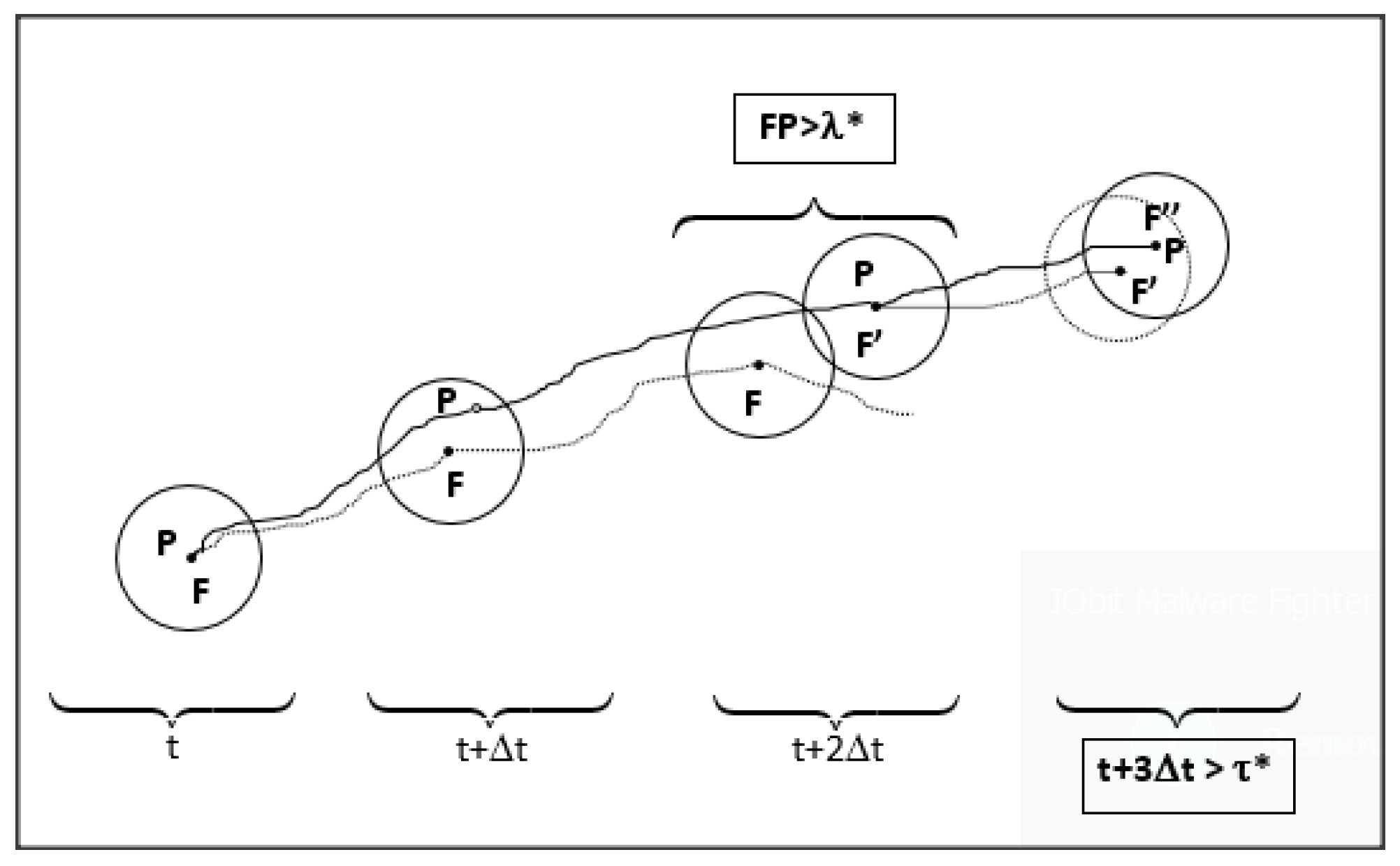
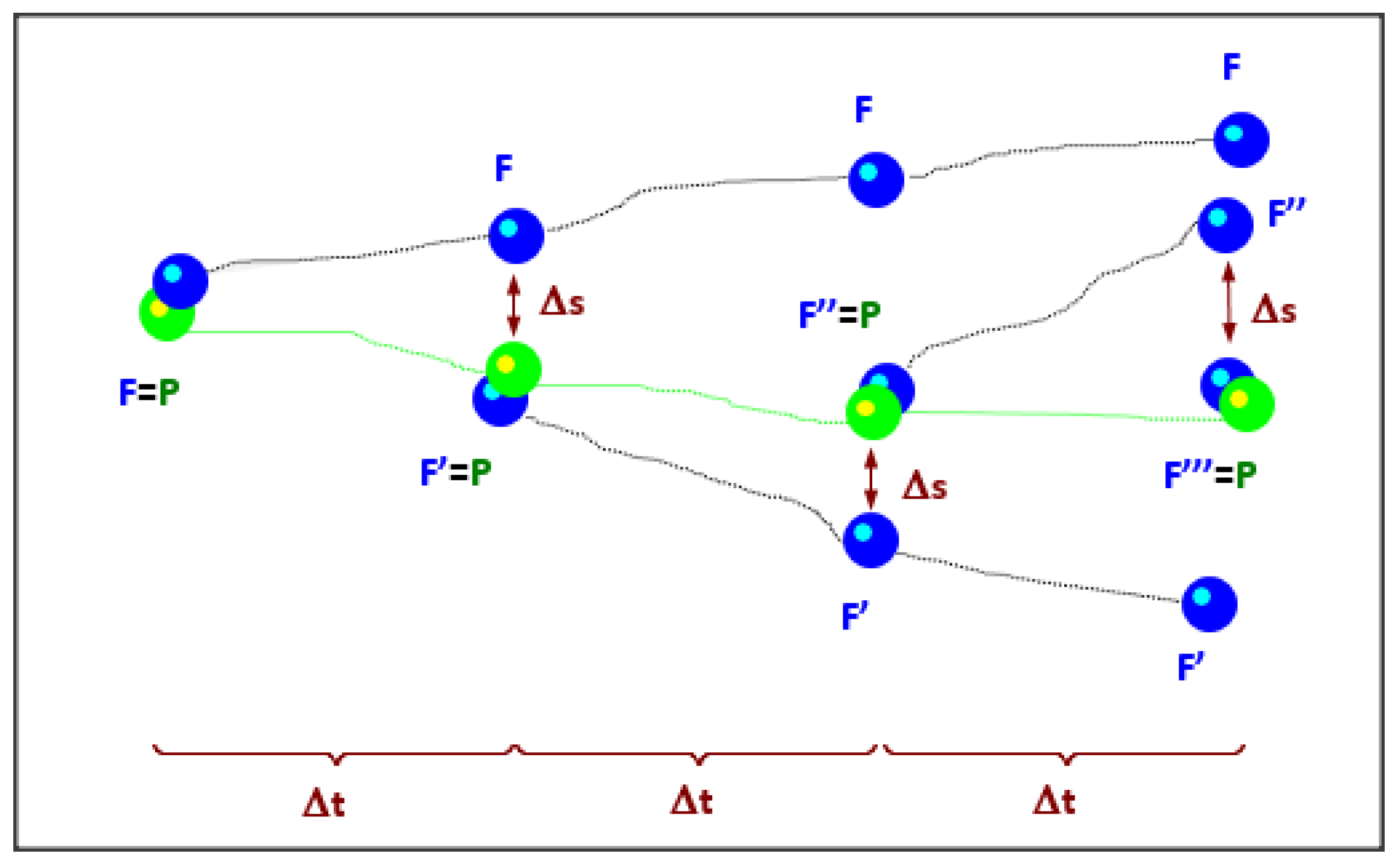

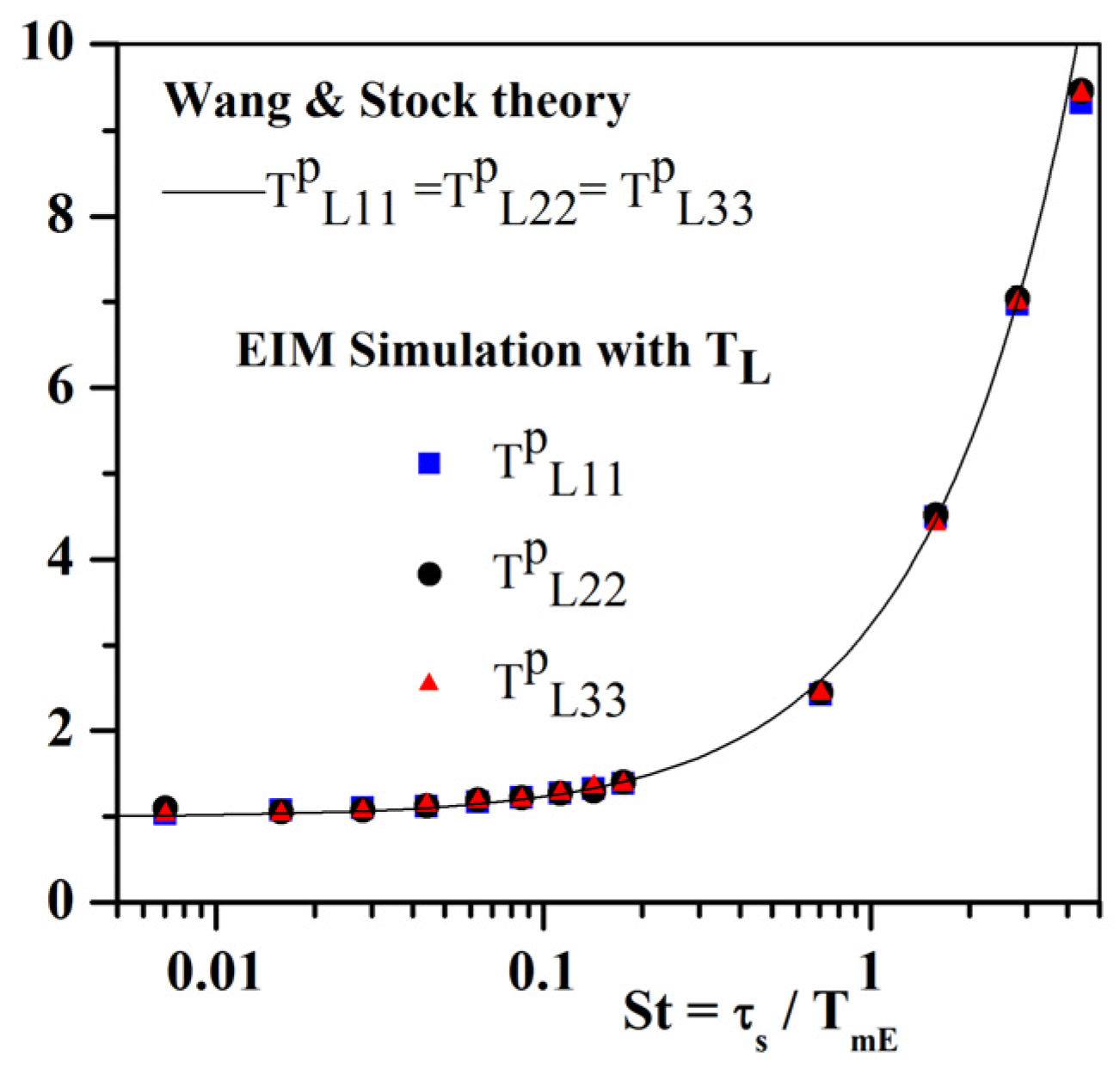
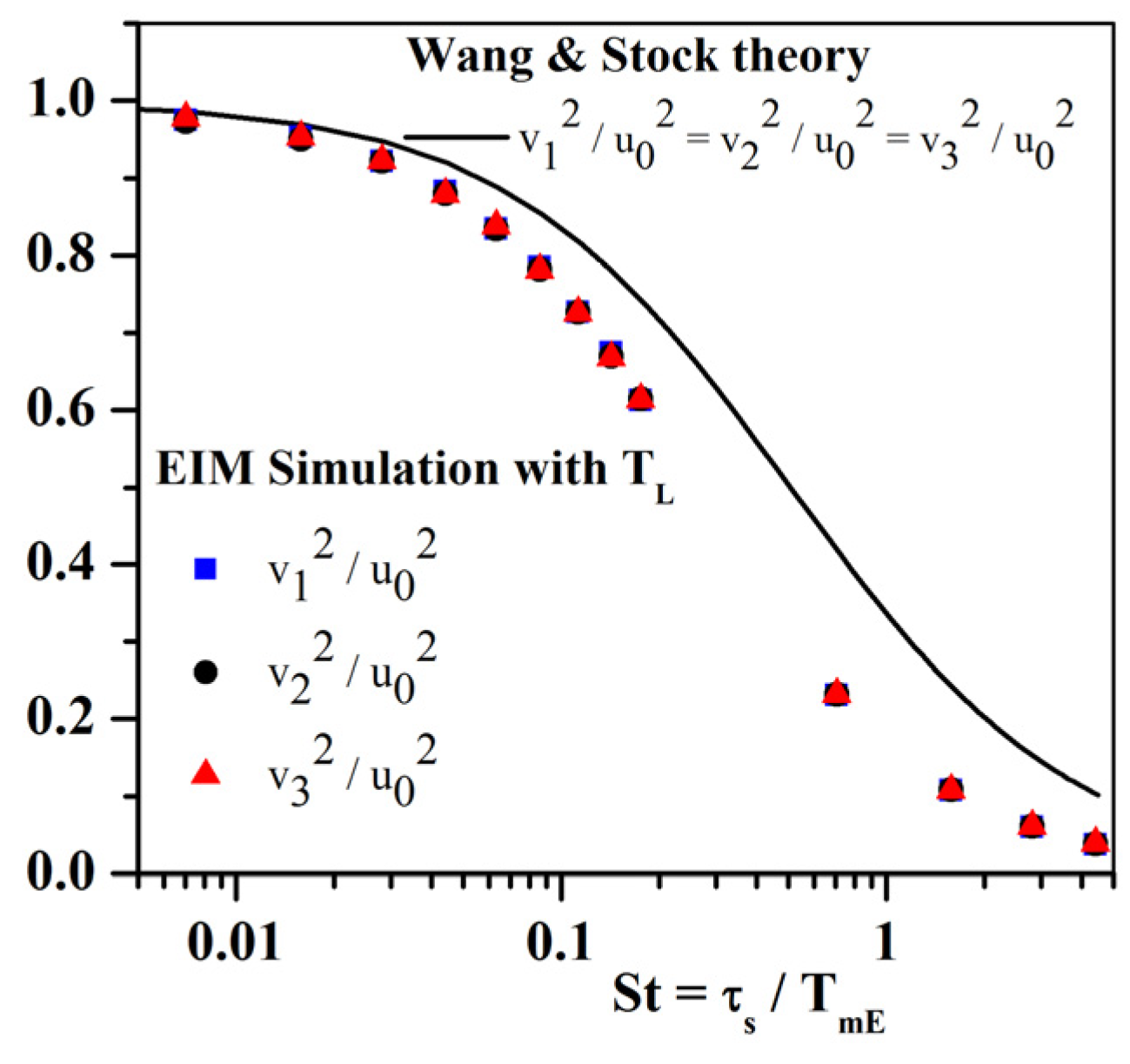
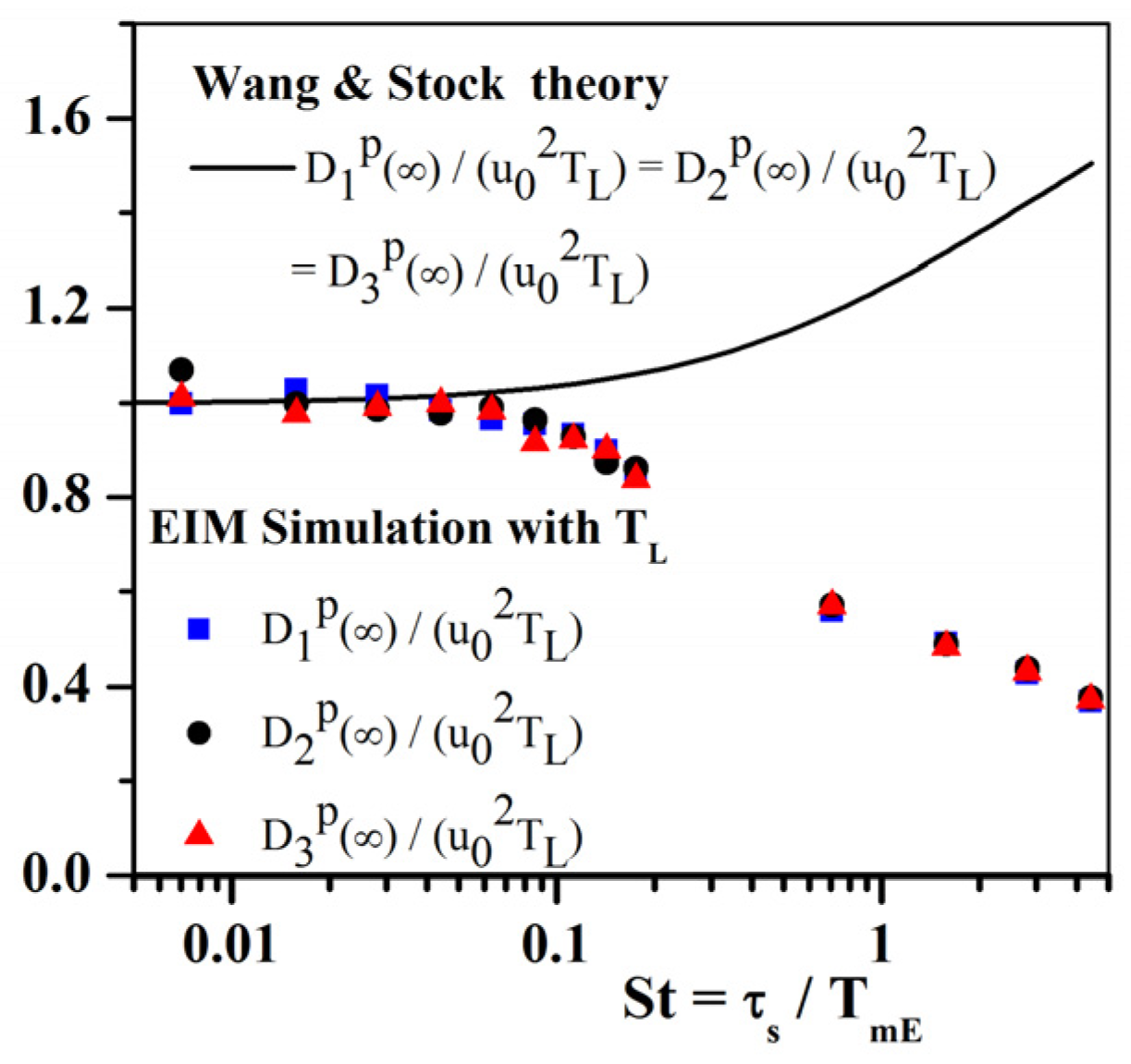
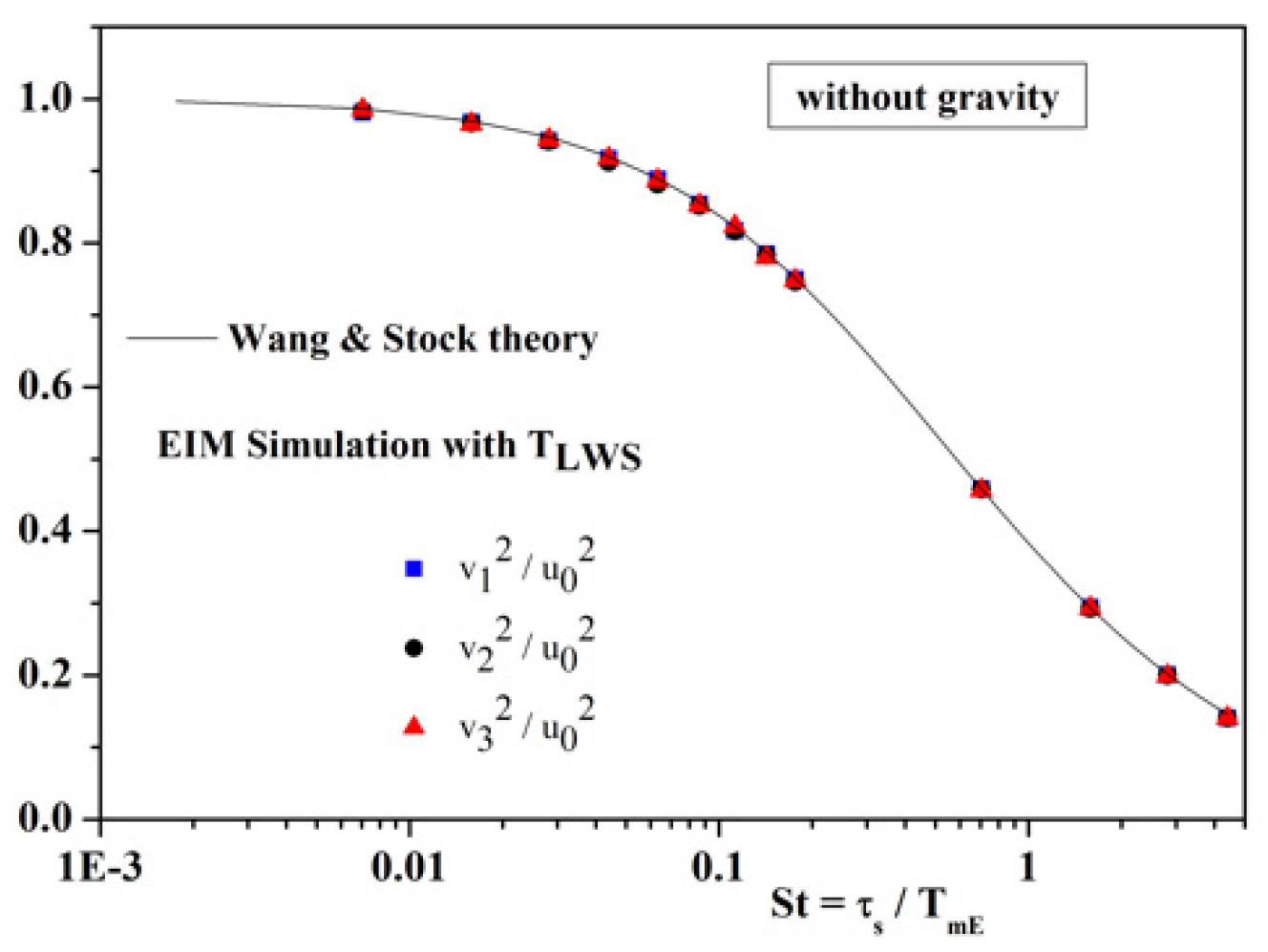

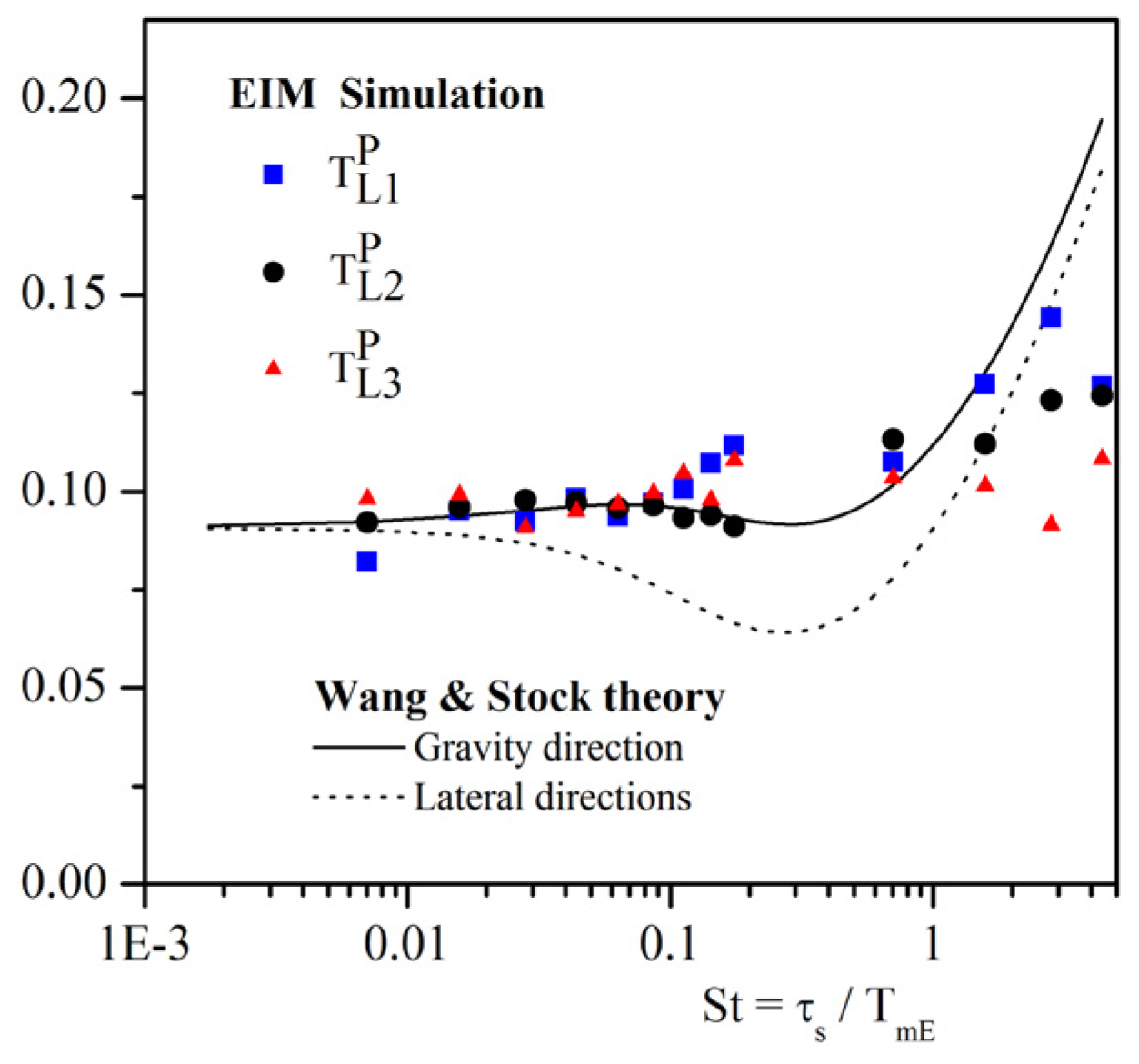
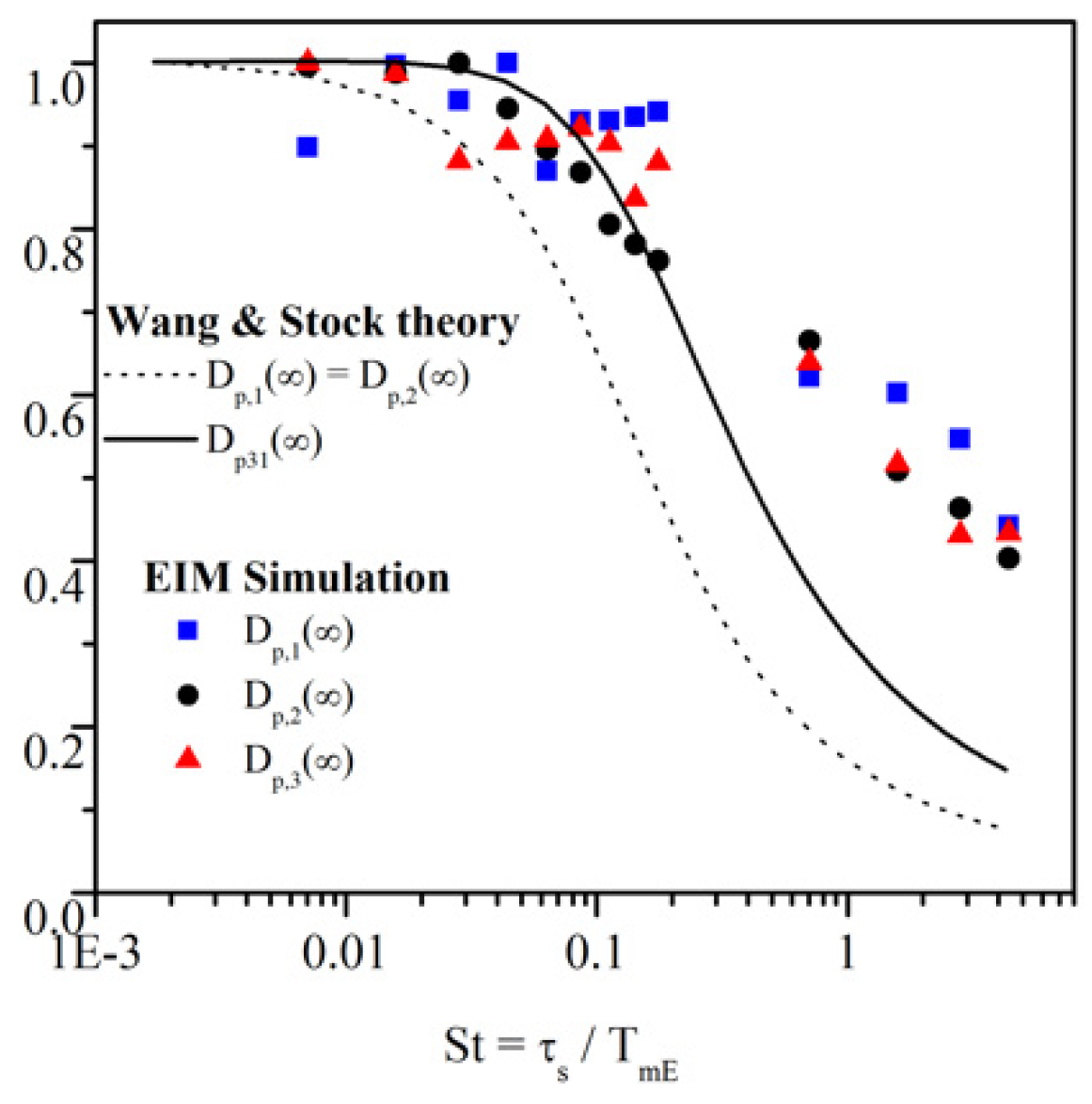
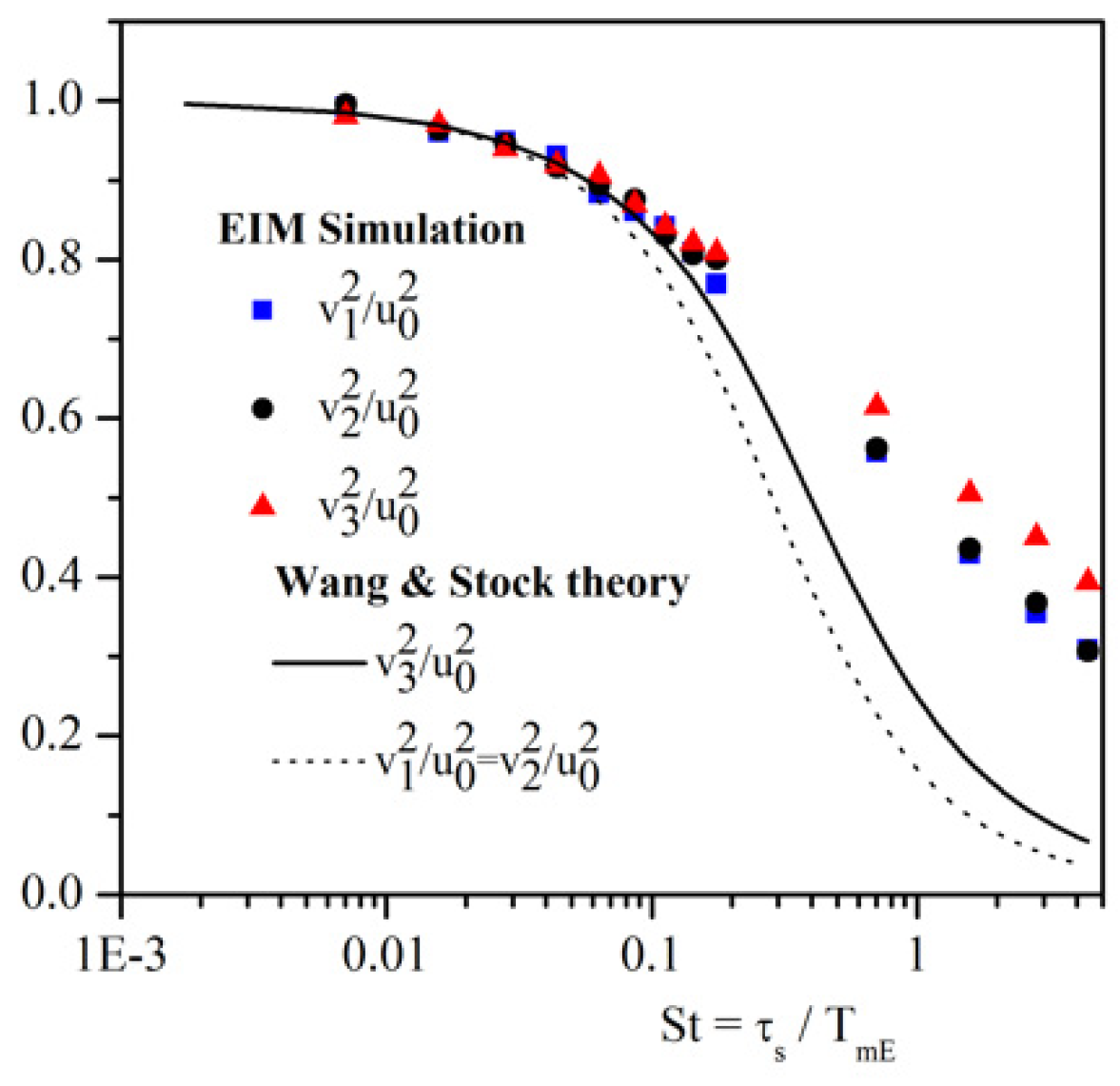

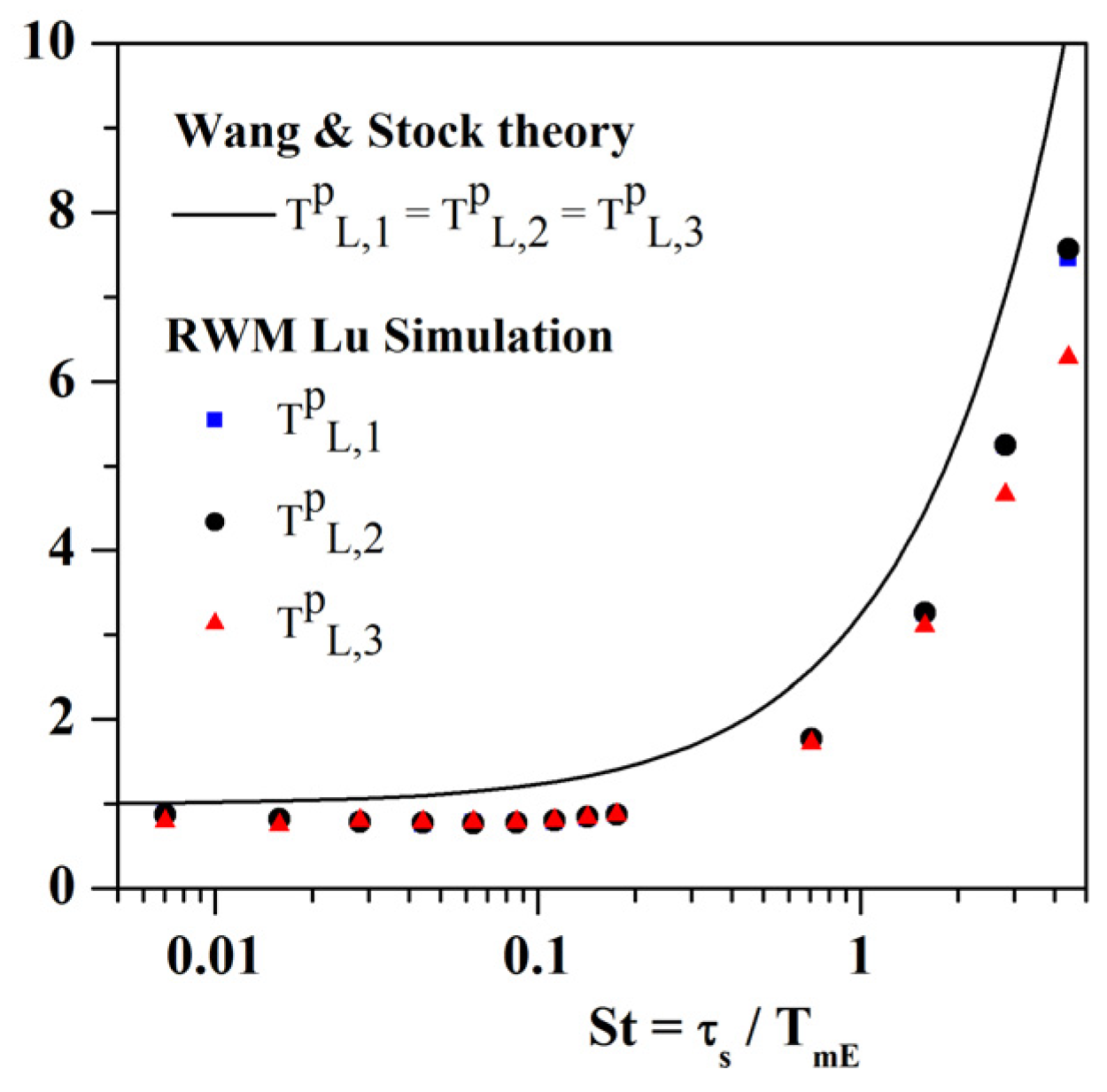
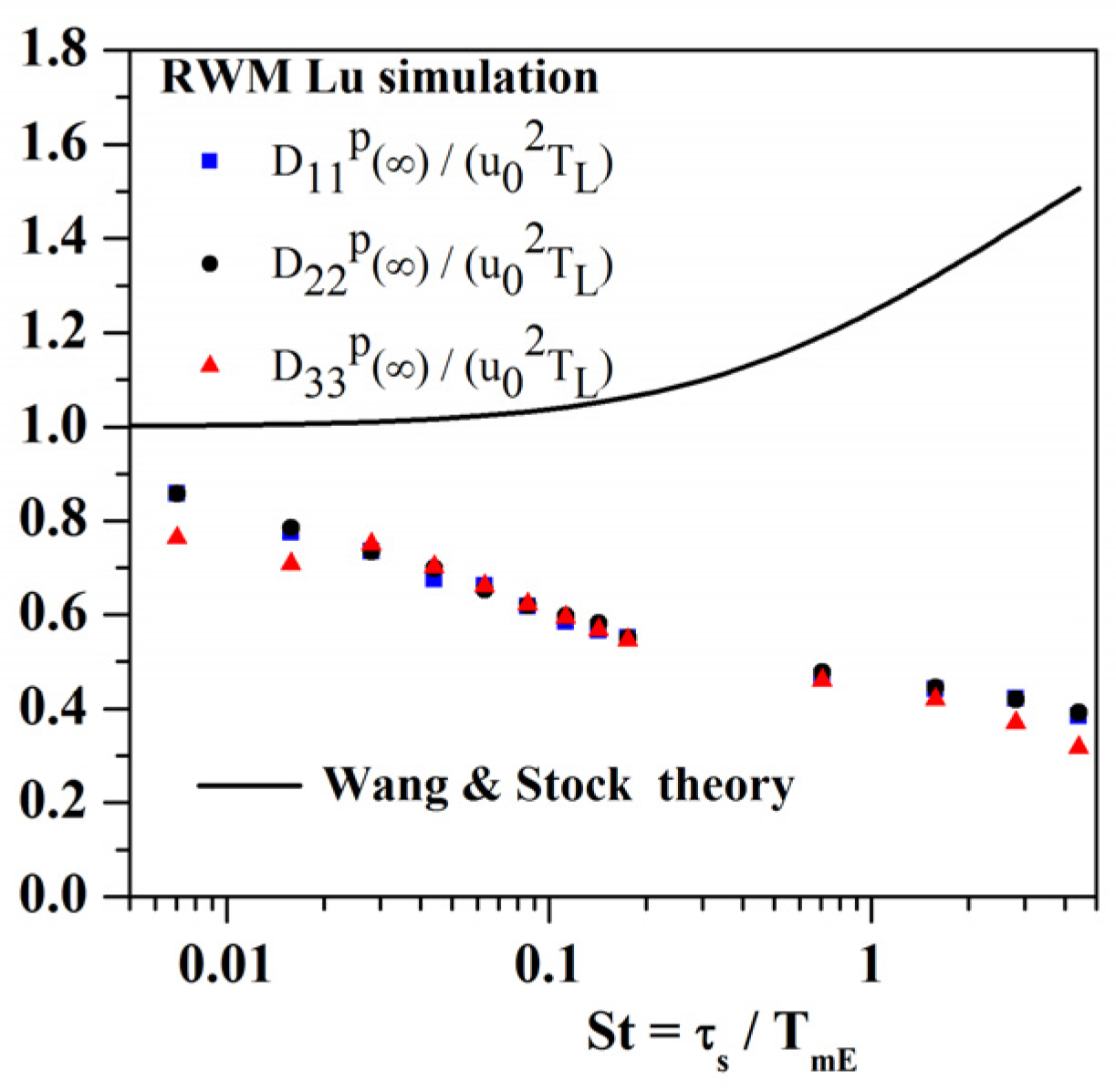
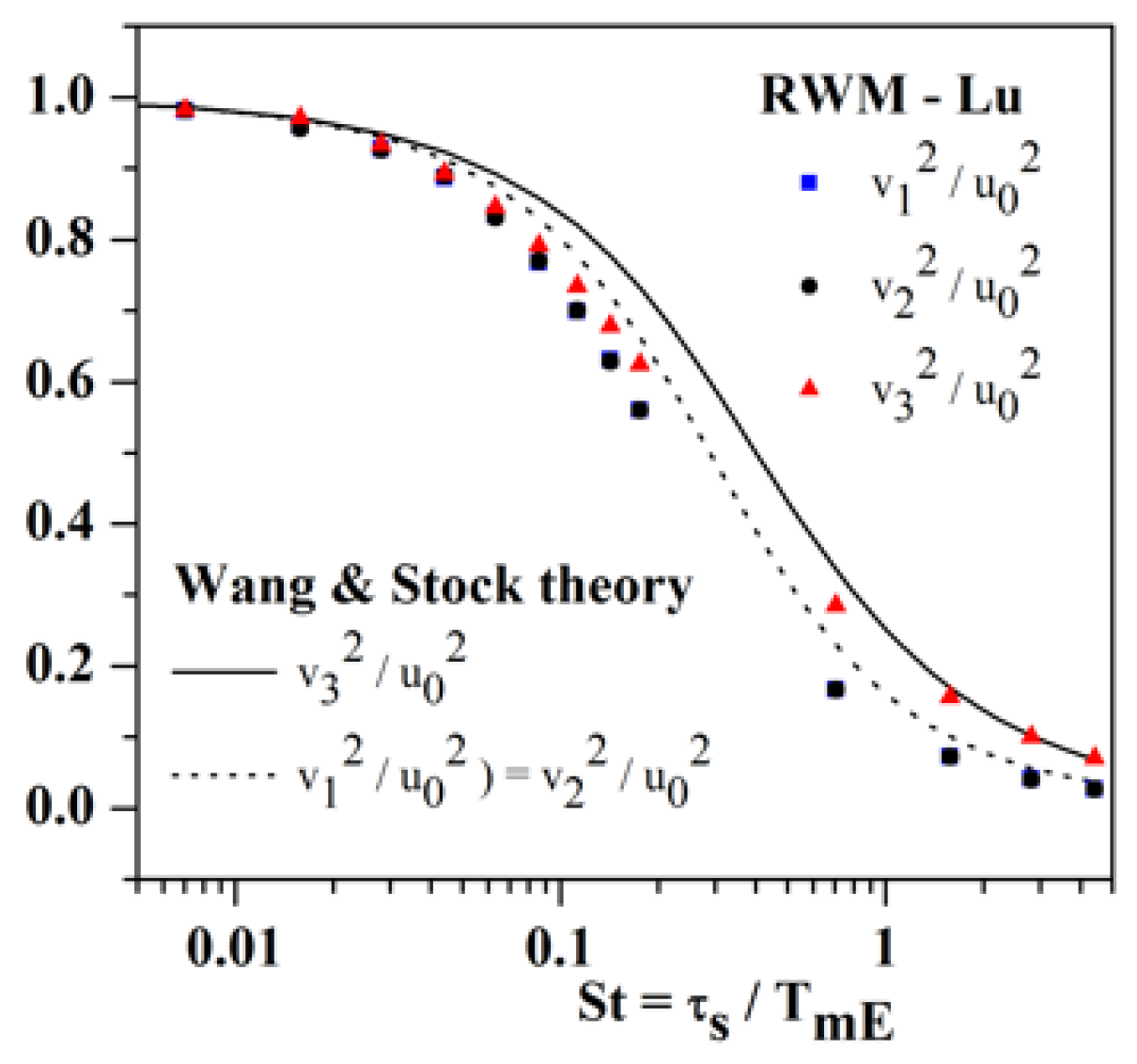
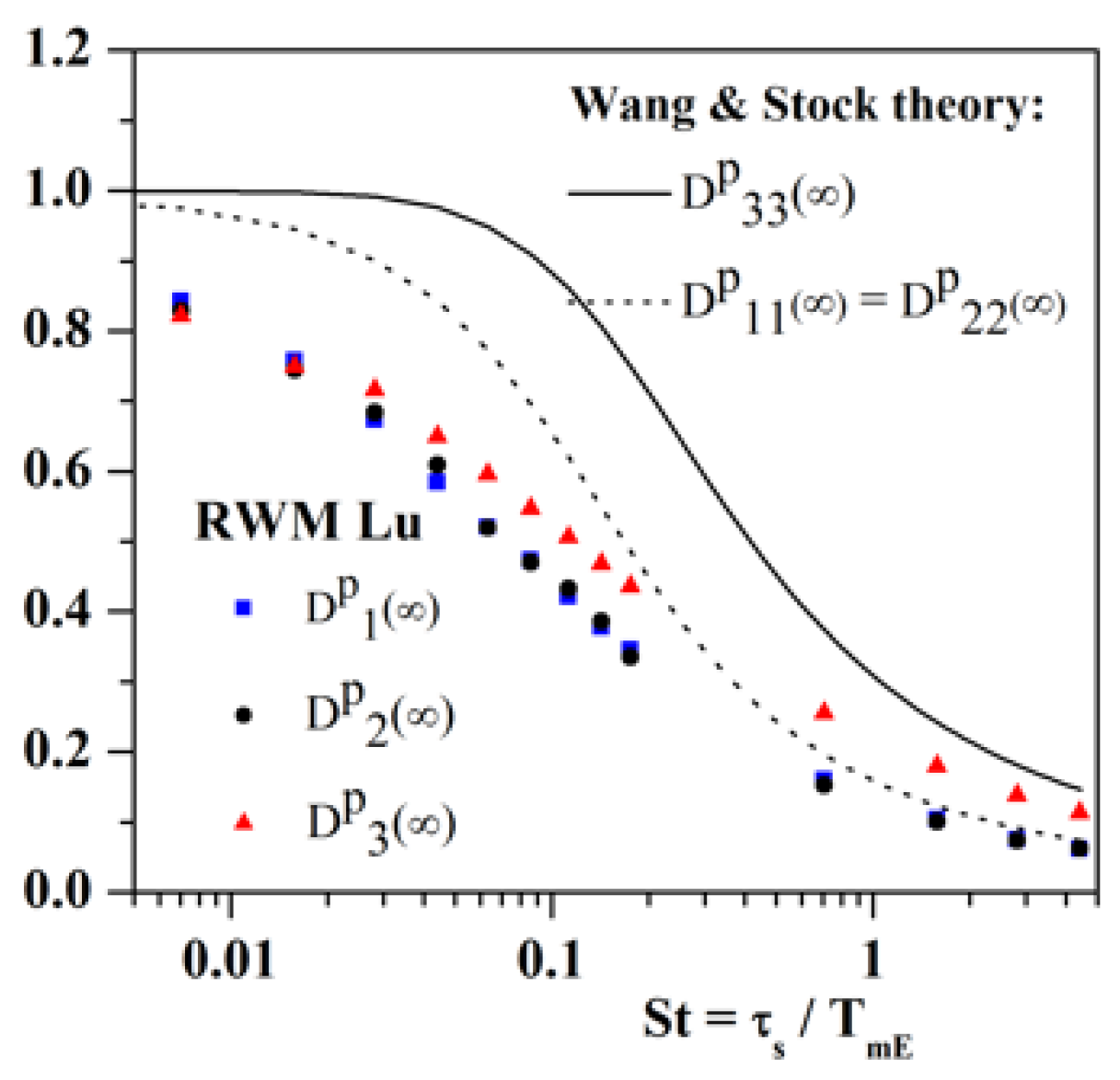

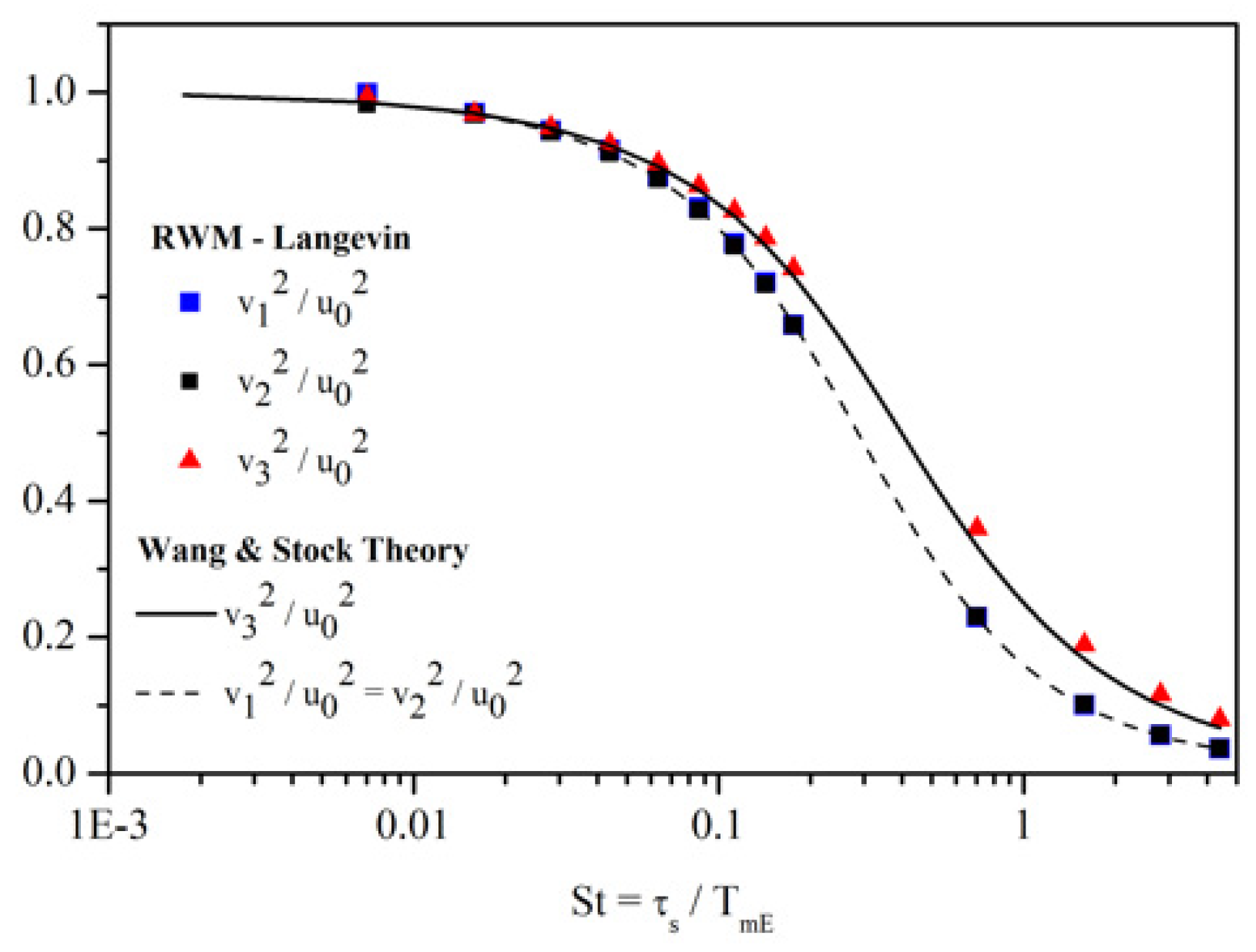
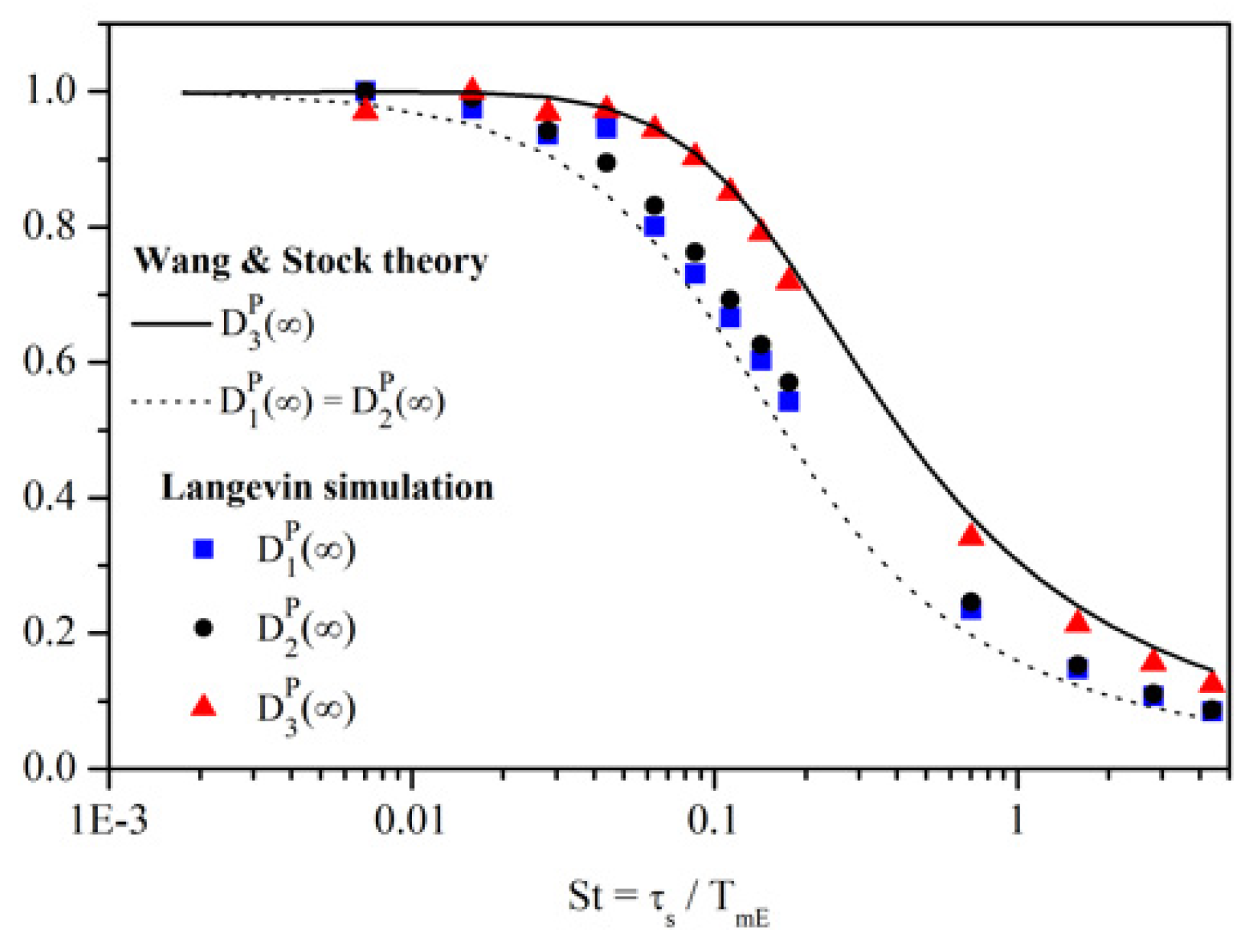
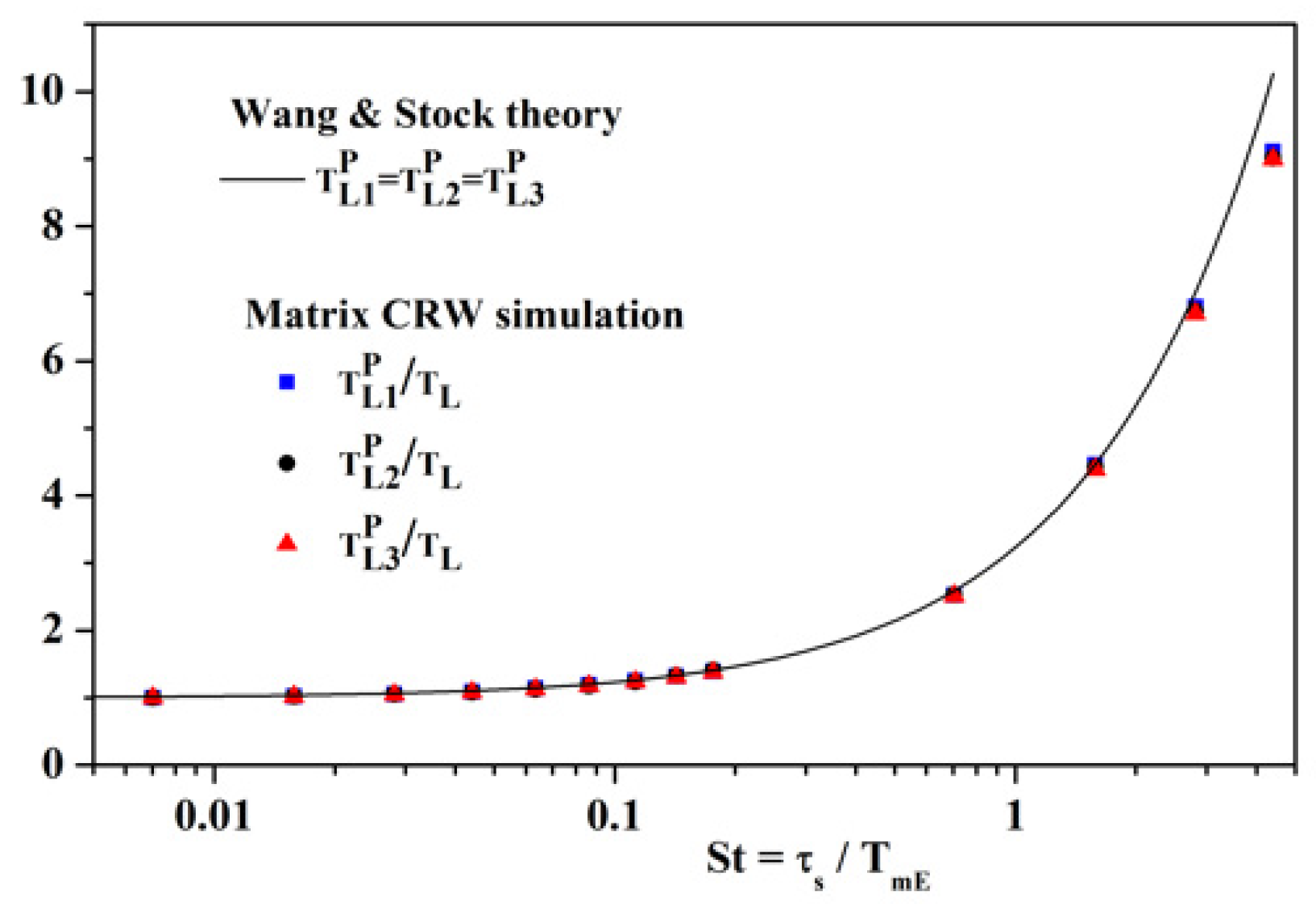

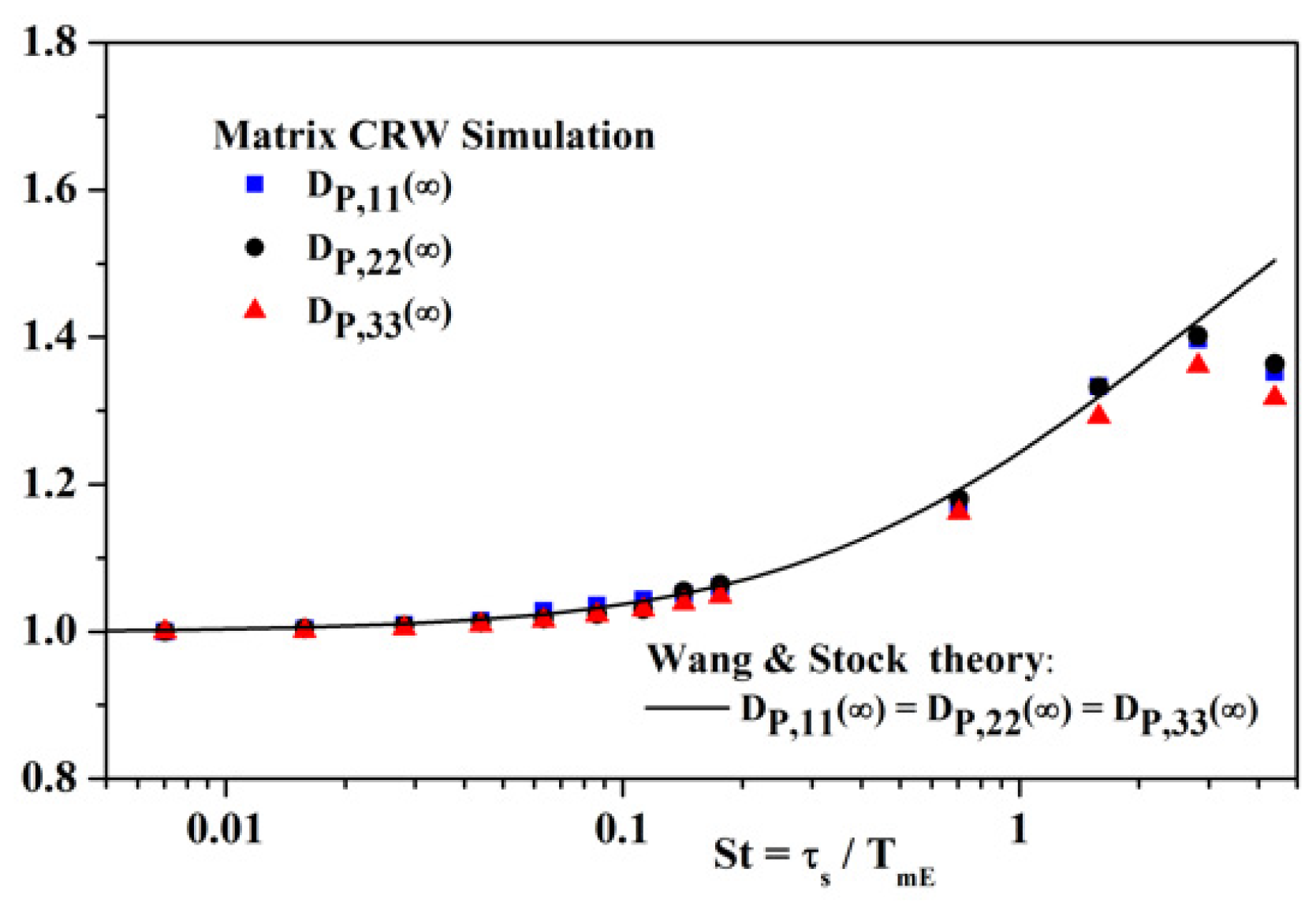
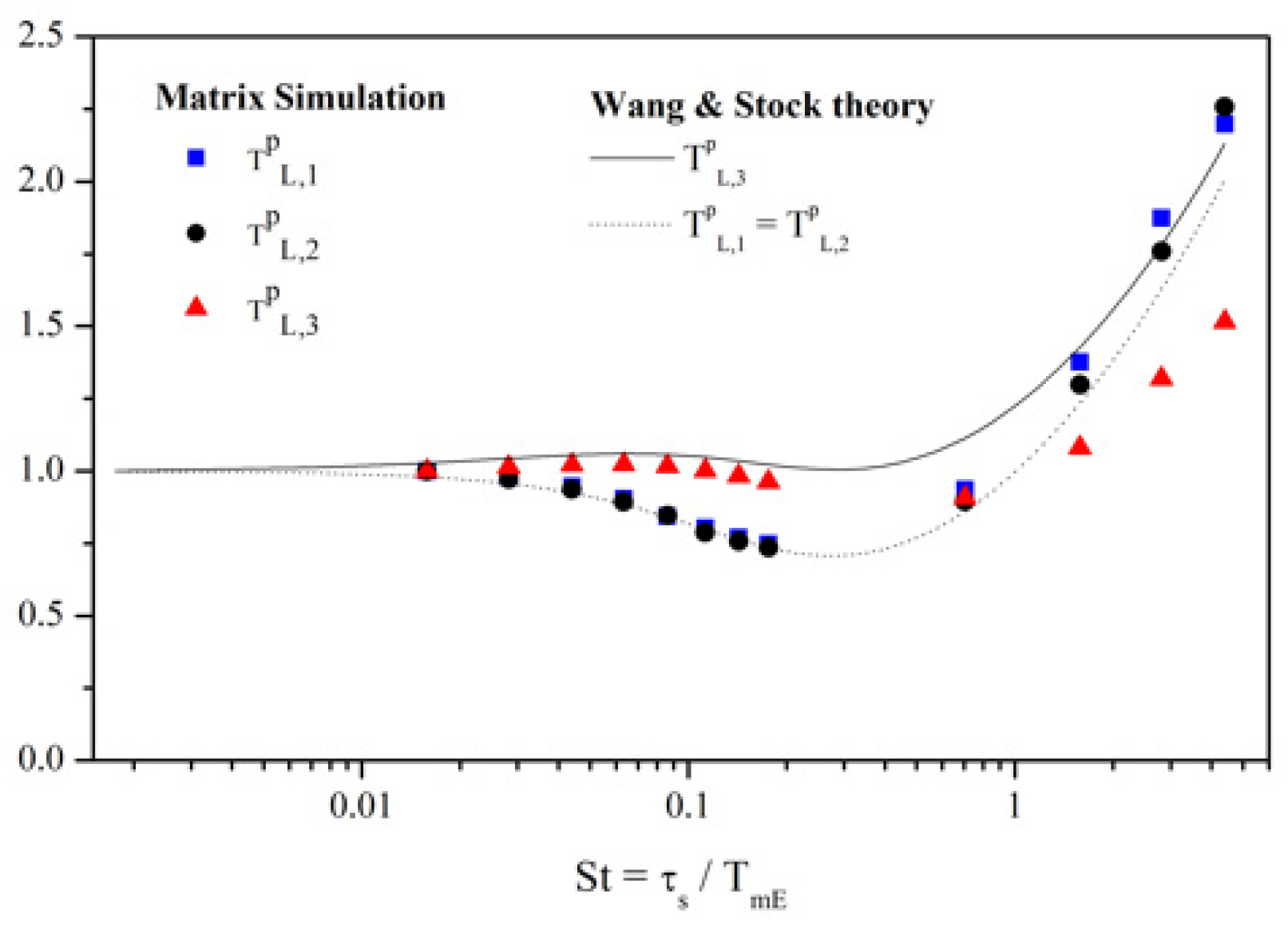

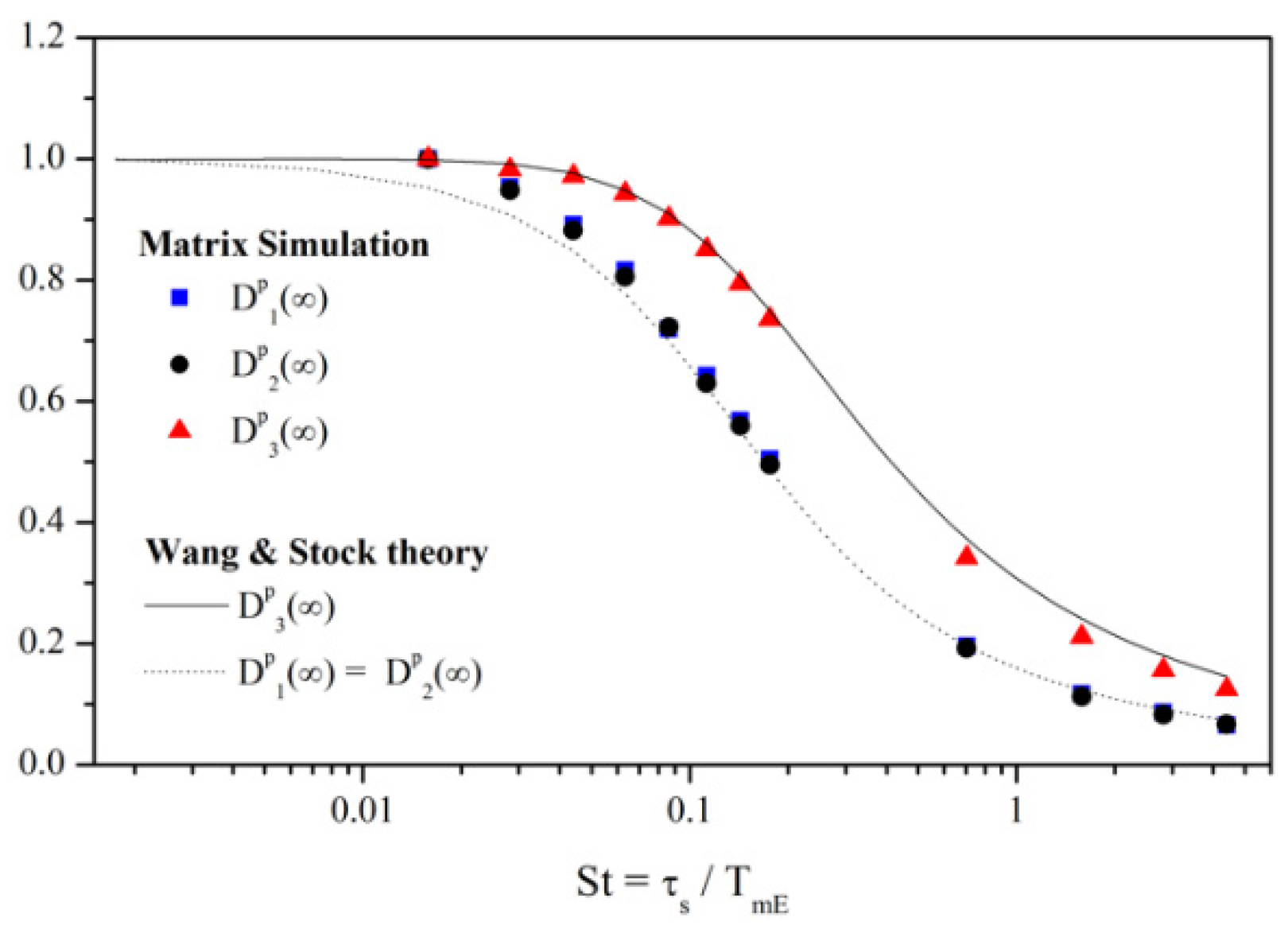
| Case | Dispersion Regime | ||
|---|---|---|---|
| 1 | yes | yes | Large structure dispersion with high-frequency cut-off and turbulence modification, inertia and CTE-CE if drift |
| 2 | no | yes | Large structure dispersion without high-frequency cut-off, turbulence modification, CTE-CE |
| 3 | yes | no | Small and large structure influence with damped particle response to high-frequency fluctuationsInertia effect (IE) and CTE-CE if drift |
| 4 | no | no | Turbulent diffusion |
| 10 | 0.003 | 0.31 | 0.31 | 0.0017 | 0.0017 | 0.023 | 0.002 |
| 20 | 0.012 | 1.23 | 1.24 | 0.0068 | 0.0068 | 0.093 | 0.017 |
| 50 | 0.07 | 7.35 | 7.75 | 0.042 | 0.0404 | 0.55 | 0.25 |
| 70 | 0.135 | 13.7 | 15.2 | 0.084 | 0.0753 | 1.3 | 0.65 |
| 100 | 0.25 | 25 | 31 | 0.170 | 0.137 | 1.95 | 1.7 |
| 120 | 0.34 | 34 | 44.64 | 0.245 | 0.187 | 2.57 | 2.8 |
| 150 | 0.47 | 48 | 69.75 | 0.38 | 0.26 | 3.62 | 4.9 |
| 200 | 0.710 | 72 | 124 | 0.68 | 0.39 | 5.42 | 9.8 |
| 250 | 0.944 | 96 | 194 | 1.06 | 0.52 | 7.21 | 16.3 |
| 400 | 1.61 | 164 | 496 | 2.72 | 0.90 | 12.3 | 47 |
| 500 | 2.02 | 205 | 775 | 4.26 | 1.13 | 15.4 | 74 |
Publisher’s Note: MDPI stays neutral with regard to jurisdictional claims in published maps and institutional affiliations. |
© 2021 by the author. Licensee MDPI, Basel, Switzerland. This article is an open access article distributed under the terms and conditions of the Creative Commons Attribution (CC BY) license (https://creativecommons.org/licenses/by/4.0/).
Share and Cite
Huilier, D.G.F. An Overview of the Lagrangian Dispersion Modeling of Heavy Particles in Homogeneous Isotropic Turbulence and Considerations on Related LES Simulations. Fluids 2021, 6, 145. https://doi.org/10.3390/fluids6040145
Huilier DGF. An Overview of the Lagrangian Dispersion Modeling of Heavy Particles in Homogeneous Isotropic Turbulence and Considerations on Related LES Simulations. Fluids. 2021; 6(4):145. https://doi.org/10.3390/fluids6040145
Chicago/Turabian StyleHuilier, Daniel G. F. 2021. "An Overview of the Lagrangian Dispersion Modeling of Heavy Particles in Homogeneous Isotropic Turbulence and Considerations on Related LES Simulations" Fluids 6, no. 4: 145. https://doi.org/10.3390/fluids6040145
APA StyleHuilier, D. G. F. (2021). An Overview of the Lagrangian Dispersion Modeling of Heavy Particles in Homogeneous Isotropic Turbulence and Considerations on Related LES Simulations. Fluids, 6(4), 145. https://doi.org/10.3390/fluids6040145






